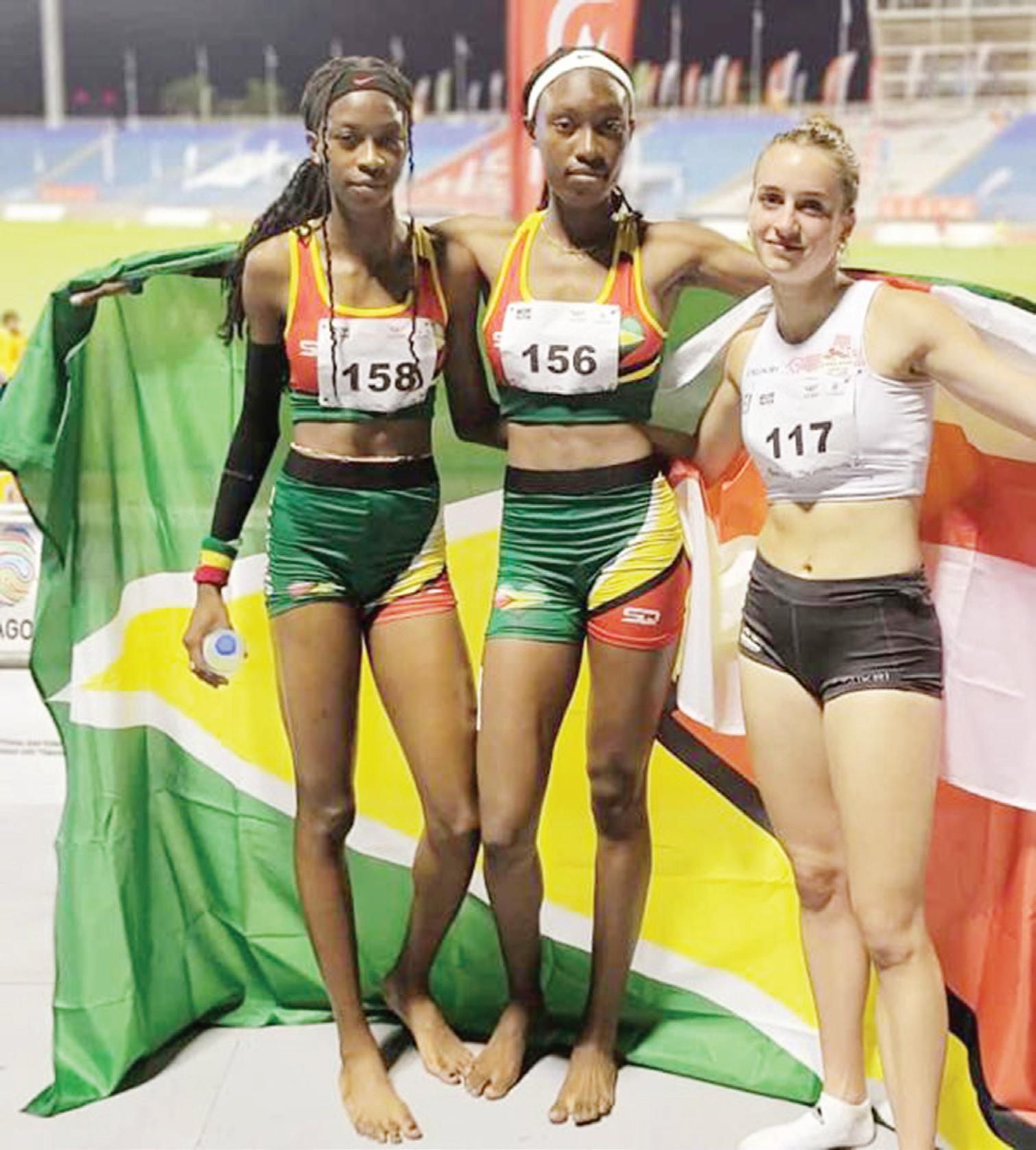


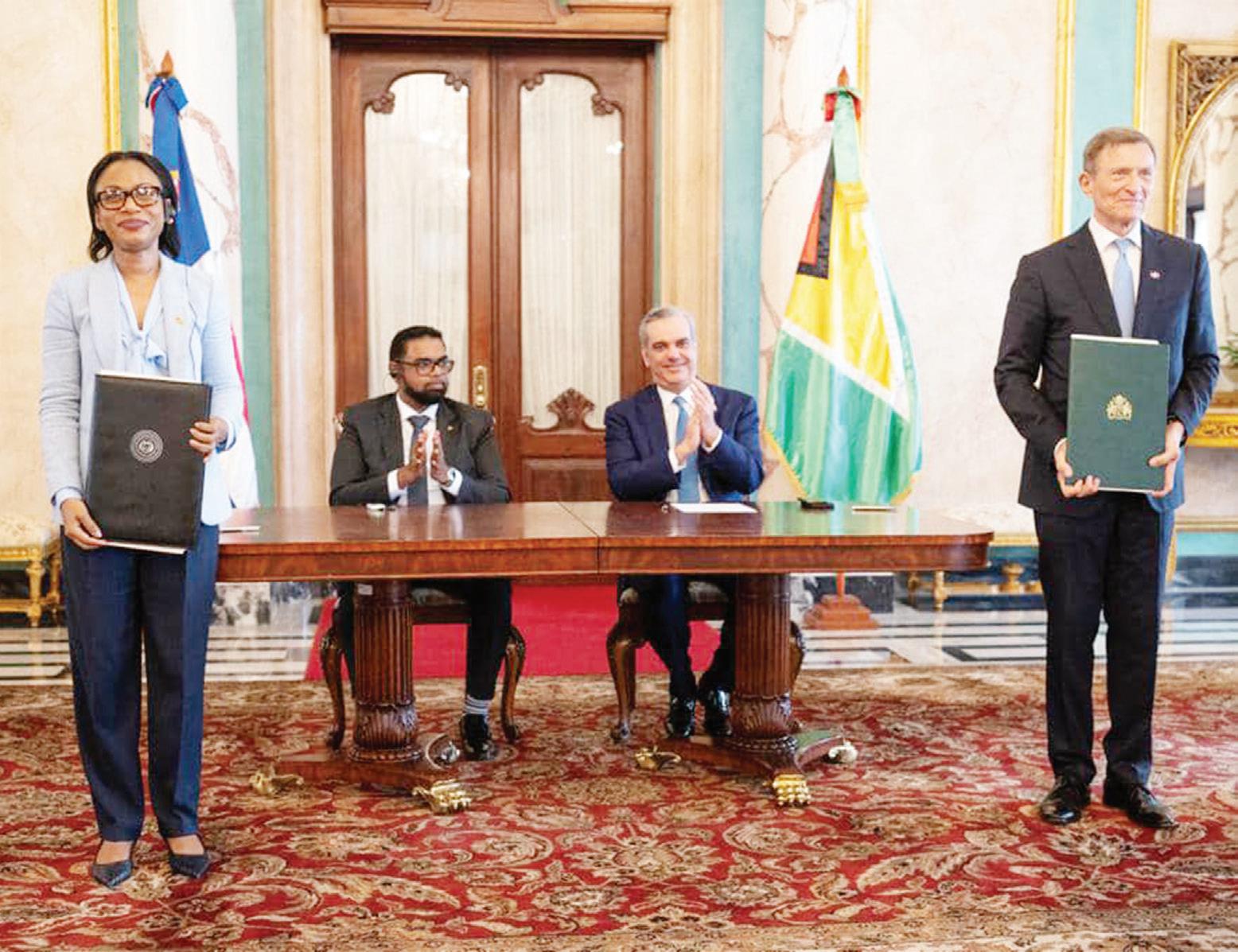
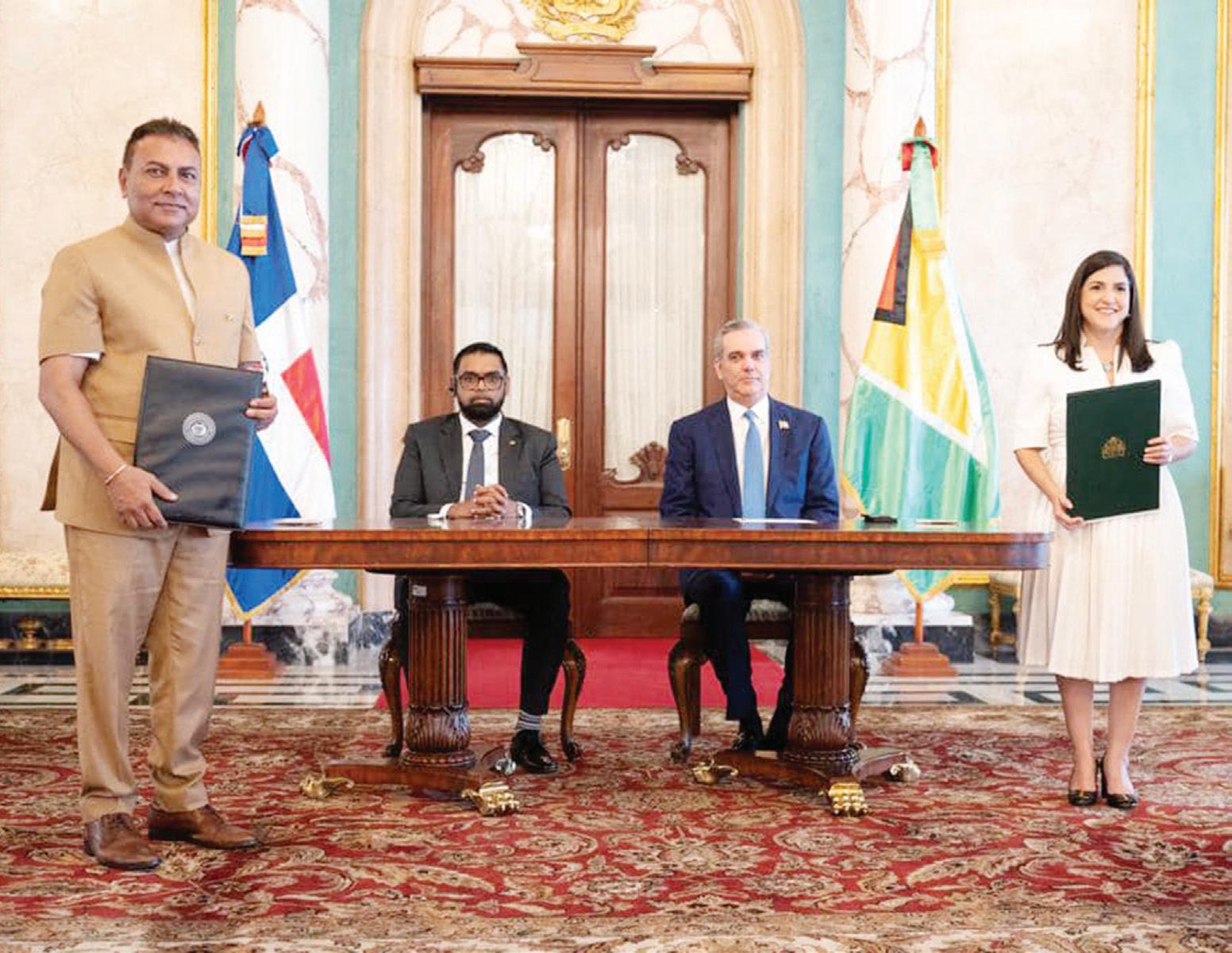


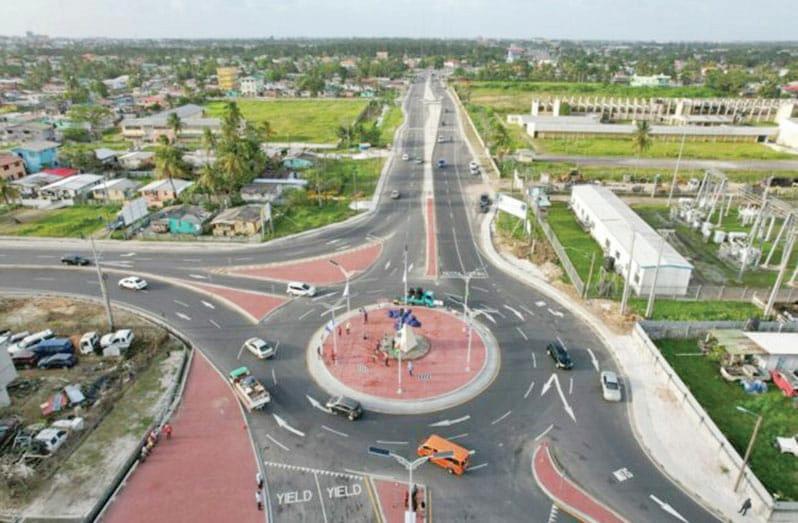









THE Dominican Republic (DR) and Guyana signed six memoranda of understanding (MoU) on Tuesday, which Guyana's President Dr. Irfaan Ali said would help the two Caribbean nations tackle regional crises more effectively.
Dr. Ali who led a high-level delegation of the private sector and government officials met with his counterpart, President Luis Abinader at the DR’s National Palace where agreements for the oil and gas industry, the establishment of an oil refinery, a petrochemical plant, and a study for participation in Guyana’s Oil Exploration Block were signed by the countries’ respective representatives.
Agreements were also signed to enhance the two nations’ agriculture, tourism and trade industries.
“These MoUs that we sign today [Tuesday] will be positioning us as two countries demonstrating our collective resolve in addressing some of the
major crises our region and the world are facing today-- the food crisis, the energy crisis and the climate crisis,” the Guyanese
Head of State said during an address to the DR press.
He further noted that the MoU results from common ideas shared between
the two countries.
“We positioned ourselves under the umbrella of common values, through democracy, the rule of law and advancing development that opens up opportunities for the people, [and] the private sector.”
Underscoring the importance of governments creating an enabling environment, Dr Ali said it is important that leaders send the right signals and build trust and confidence among private sector bodies.
“The tone that we set is imperative for the joint collaboration of our private sectors,” he said.
Dr. Ali further noted the countries will not limit their collaborations with memoranda of understanding and a working group will be further analysing other areas of collaboration.
Technology and the digitization of the world through artificial intelligence is one area that will be explored.
The MOUs
The first of the six MoUs signed between the
two nations is an agreement for the DR government to study the possibility of exploring one of Guyana’s oil blocks.
The second agreement inked is for the establishment of an oil refinery. The DR government will take the majority share in this project, with a stake of 51 per cent.
The two countries will also work on the establishment of a petrochemical plant in Guyana.
Meanwhile, the Chief Executive Office of Guyana Investment Office, Peter Ramsaroop and the director of ProDominicana, Biviana Riveiro, signed an agreement to improve bilateral investment relations. This agreement will facilitate foreign direct investments.
Guyana’s Minister of Tourism, Industry and Commerce, Oneidge Walrond, signed an agreement with her counterpart Minister of Tourism, David Collado, to promote the development of the countries’ tourism industries.
Walrond also inked an agreement with DR’s Min-
ister of Foreign Relations, Roberto Álvarez, for trade co-operation.
Agreements were also signed for the joint production of corn, soya beans, poultry and agricultural products.
Dr. Ali’s visit was planned since June of the same year when President Abinader travelled to Guyana with numerous businessmen.
First Lady Arya Ali; Foreign Secretary, Robert Persaud; Chief of Staff of the Guyana Defence Force (GDF), Omar Khan; Commissioner of Police, Clifton Hicken; National Security Adviser, Gerald Goveia; Director of Presidential Affairs, Marcia Nadir-Sharma; Director General of Guyana’s Agriculture Ministry, Madanlall Ramraj; Director of the local content secretariat, Martin Pertab, Legal Officer at the Ministry of Natural Resources, Micheal Munroe, and Chairman of the New Hayven commercial, Floyd Haynes accompanied the Head of State.

SENIOR Minister within the Office of the President with responsibility for Finance, Dr. Ashni Singh, on Wednesday, told the National Assembly that the professionals at the Bureau of Statistics are continuing to advance works on the national population census.
Dr Singh was, at the time, responding to an oral question posed by opposition member Annette Ferguson at Wednesday’s sitting of the National Assembly.
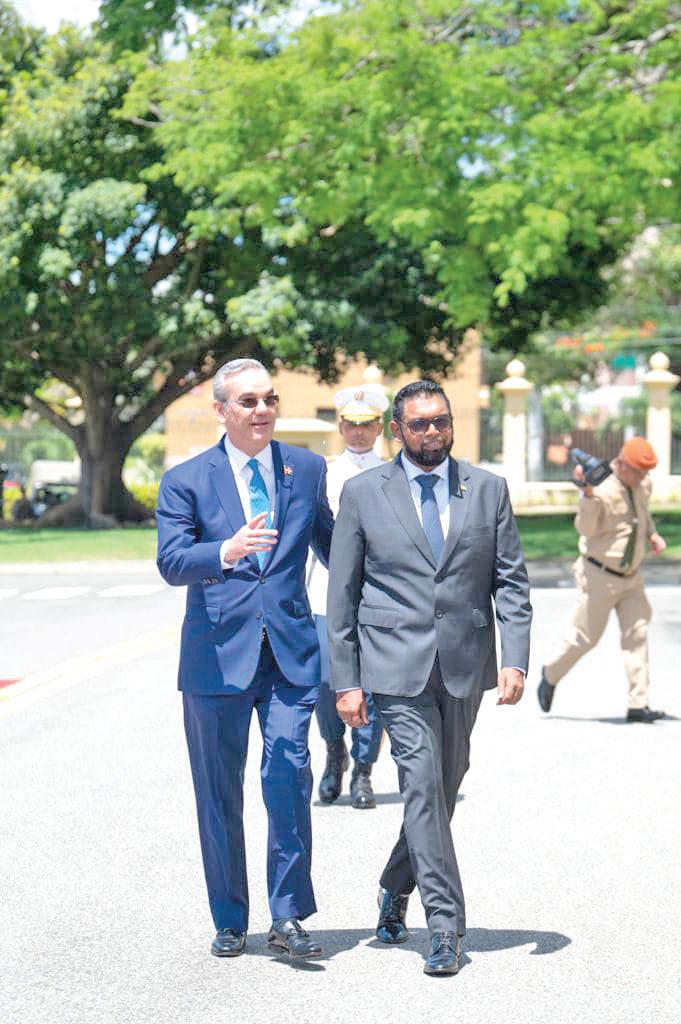
The member questioned what percentage of the population has been counted thus far, to which the Finance Minister not-
ed that one could not say what percentage of the total population has been counted if the census has not yet been completed. He said, “The total
population will only be known when the census is completed and so, therefore, to ask what percentage of the total population has been counted thus far
reflects the honourable member’s persistence in providing amusement to this house and to the people of Guyana.”
Meanwhile, when
asked about the presentation of the preliminary census report, Dr Singh assured the house that members of the team at the Bureau of Statistics continue to work on the census and advance works to have same completed and sent to the national assembly.
He revealed that teams are doing repeat visits to some regions so as to get correct counts of homes that were not counted during the initial stages of the census.
“The team at the Bureau of Statistics is in fact doing that very exercise of going back to the homes that were not enumerat -
ed, going back to regions including those that were mentioned in the budget speech and I’m pleased to say other regions in fact where additional work is required,” the Finance minister said.
The Bureau of Statistics, in September 2022, began the enumeration process of counting all people in Guyana as part of the National Population and Housing Census 2022. At that time it was noted that the 2022 census was a historic one as the enumerators would collect data electronically instead of using paper, as was done in the past.
DR. Tiffany Fiedtkou, an esteemed anaesthesiologist at Georgetown Public Hospital Corporation (GPHC), performed a life-saving emergency intervention that has impressed the medical community with her dedication and expertise.
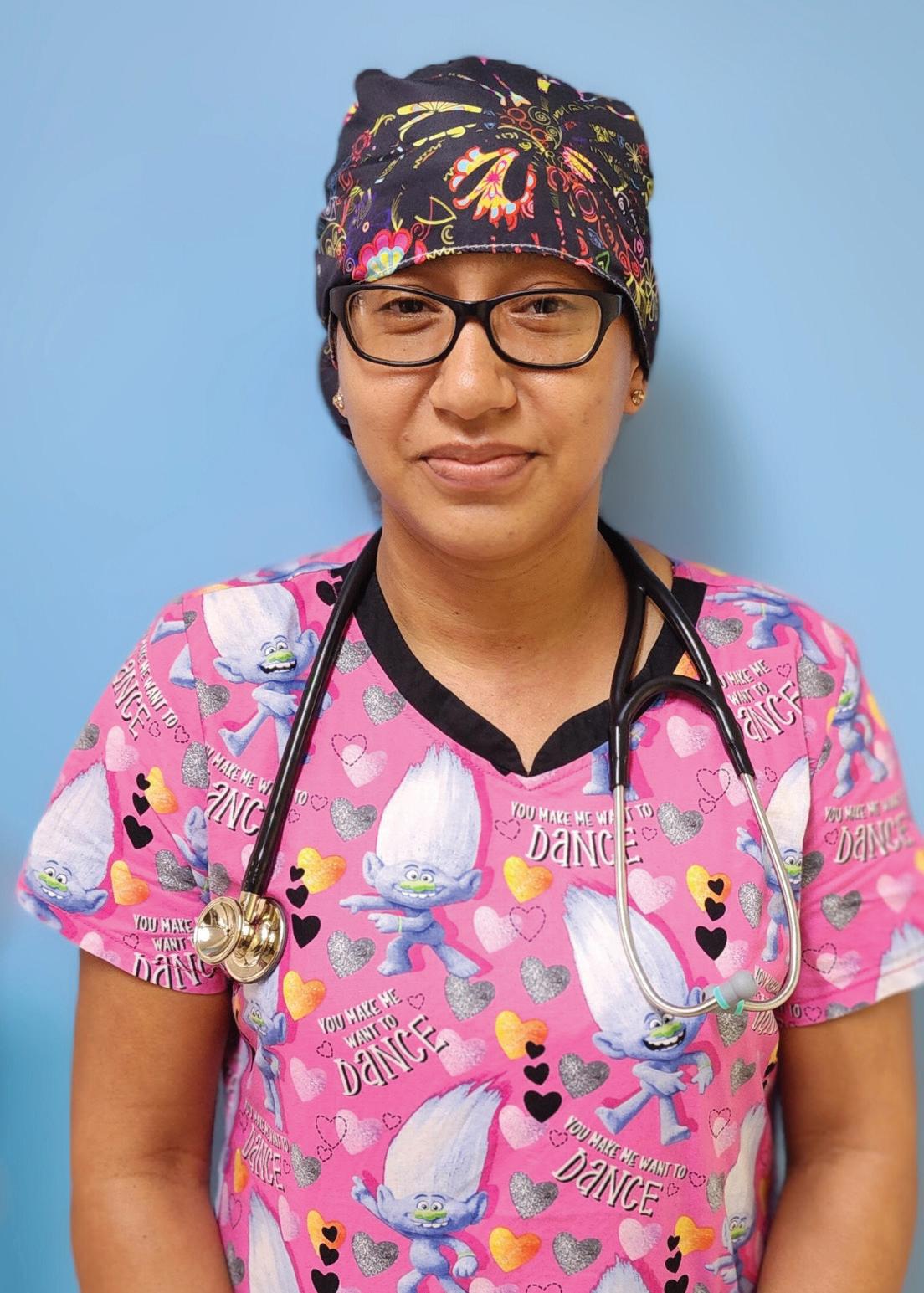
The young female patient faced a dire medical crisis but survived, thanks to Dr. Fiedtkou's swift and selfless action. The young lady, at Mabaruma Regional Hospital, Region One, was grappling with a life-threatening ruptured ectopic pregnancy. In a hemodynamically unstable state, she faced a precarious situation that prevented her from being transported to Georgetown for immediate care.
Dr. Fiedtkou, although not on duty at the time, received the distress call at 02:00 am and made a courageous decision to volunteer her specialised skills to the critical emergency.
Braving the early hours of the morning, Dr. Fiedtkou’s journey commenced with a medivac chopper provided by the Guyana Defence Force (GDF) medical evacuation operation (MEDIVAC). Equipped with essential blood products and anaesthesia drugs, she touched down in Mabaruma at 05:30 am, ready to confront the medical crisis head-on.
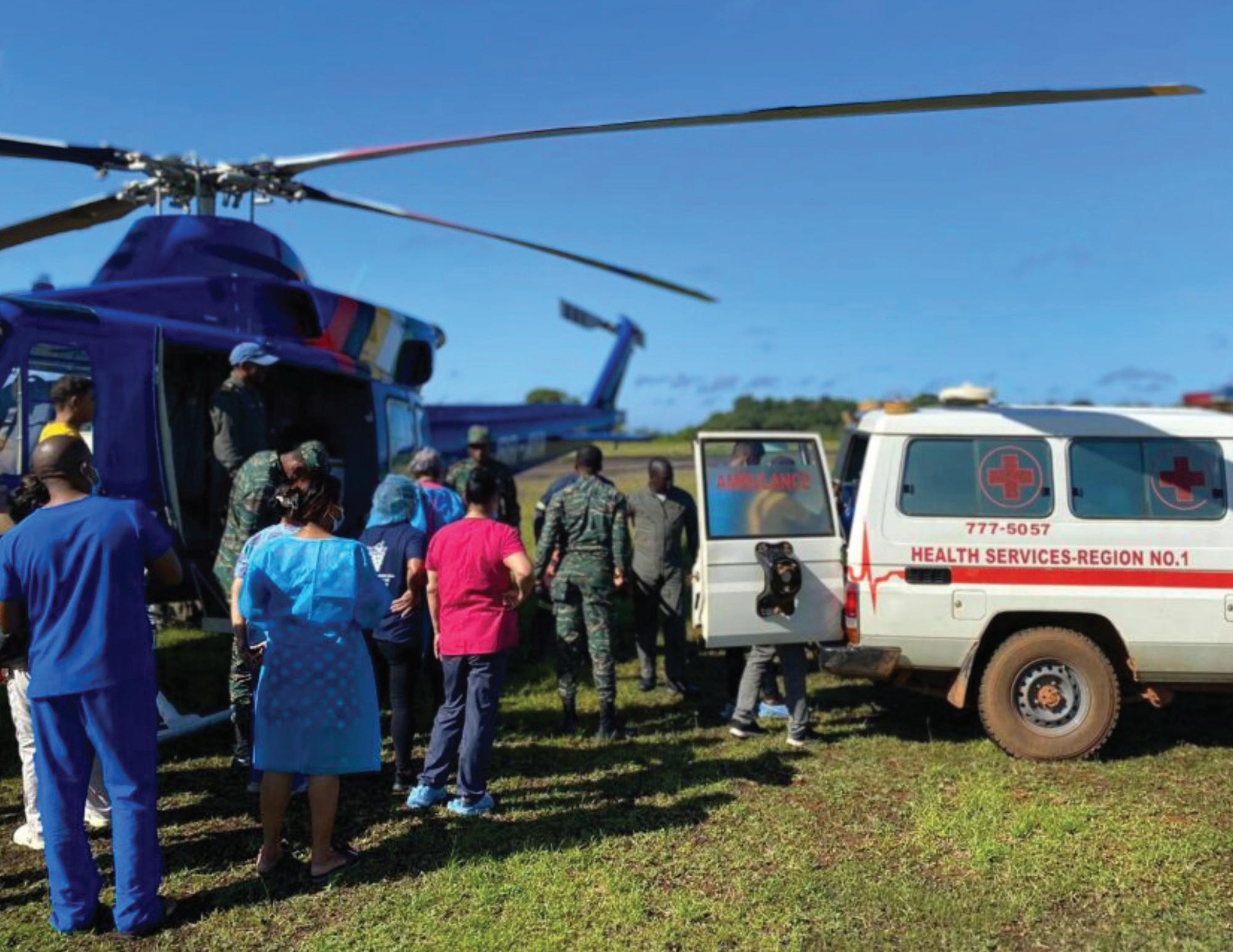
Dr. Fiedtkou was met with the patient, characterized by extreme pallor and an irregular heart rate—a clear indicator of shock resulting from significant blood loss. She immediately initiated an examination and orchestrated the patient’s transfer to the operating room.
Collaborating with Gynecologist, Dr. Ravelo Correoso, the surgical procedure commenced at 06:05 am. The surgery revealed a staggering 3.5 litres of blood within the abdomen, a life-threatening situation swiftly addressed by the medical team. Dr. Fiedtkou administered vital blood products and skillfully managed the patient’s ventilation, ensuring her stability.
Remarkably, by 06:50 am, the patient was successfully extubated and placed under observation for 30 minutes before being deemed stable enough for transportation to Georgetown. Arriving at the Accident and Emergency Unit at GPHC, she now rests in the maternity ward on the path to recovery.
Reflecting on the intense experience, Dr. Fiedtkou described the intervention as both exhilarating and emotional. This extraordinary circumstance marked her first time operating in such a highstakes environment, showcas-
Continued on page 5


THE agriculture sector in Guyana is set to be transformed with the approval of $5.6 billion by the National Assembly on Wednesday.
The National Drainage and Irrigation Authority (NDIA) received approval for $2.5 billion for additional resources, $437 million went to the National Agricultural Research and Extension Institute (NAREI), and the New Guyana Marketing Corporation received $25.4 million.
Minister of Agriculture Zulfikar Mustapha, while responding to questions posed by the opposition members of parliament, explained that the sums being sought are as a result of additional projects to be executed upon request of
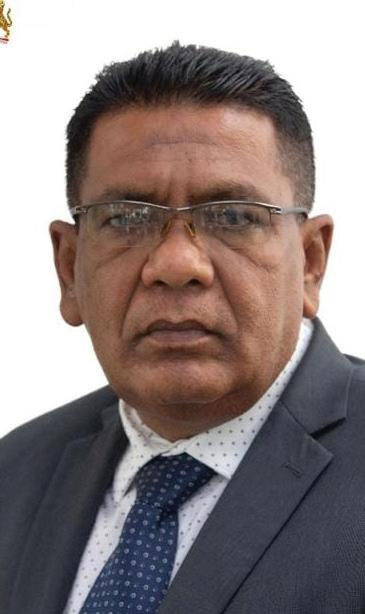
residents during outreaches.
“We have a number of other projects that people are now requesting and we want to start those projects to put the system in place to continue to improve our infrastructure,” Minister Mustapha informed the House.
Under the $2.5 billion supplementary funding for NDIA, rehabilitation and repairs to existing drainage and irrigation structures will be executed in Region Two.
Additionally, the minister explained that $69 million will be expended by NAREI to rehabilitate 11 nurseries across the country.
“What we have now in this country, we have a de-
mand for planting materials. We have seen over the last three years farmers coming onboard in droves, food production has grown tremendously, so all the nurseries in our country, we will ensure that we develop it to be more responsive to the needs of the farmers,” he pointed out.
NAREI will be working to develop large scale tissue culture with $268 million cleared on Wednesday.
Sums were also green-lighted to support the Agriculture and Innovation Entrepreneurship Programme, where shade houses are being established to incorporate more young people in the agriculture sector.
“That shade house at Mon Repos has already earned $50 million for this year already. Less than a year, they already earned $50 million. I am looking now to take this programme across the country where we will purchase another 100 shade houses to take it to places like Buxton, Region Six, Linden, Canal Polder, Region Two, so that we can have all the young people embrace agriculture,” he added.
Critical drainage and irrigation works will also be executed in Regions Two, Three, Four, Five and 10 with $4 billion cleared.
Meanwhile, the Guyana Livestock Development Au-


thority (GLDA) received $100 million to facilitate pasture development in Regions Two, Three, Five and 10 and according to Minister Mustapha, this will advance the livestock industry in Guyana.
The Guyana Sugar Corporation also received $1.5 billion to facilitate the rehabilitation of 1,572 hectares of temporary abandoned lands at the Albion, Blairmont, Rose Hall and Uitvlugt estates.
The agriculture minister also relayed to the house that the Rose Hall sugar estate will be reopened by the end of September, a commitment made by the government.
From page 4
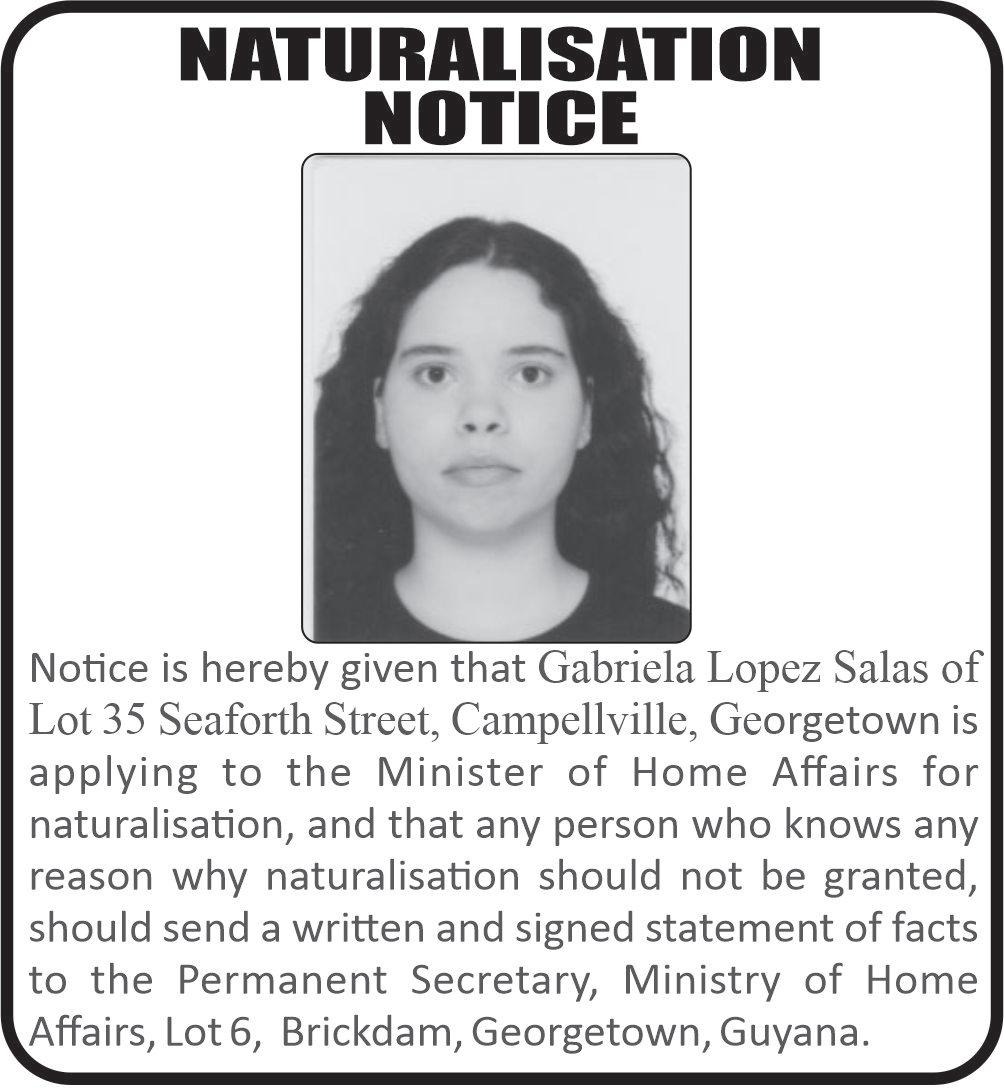
ing her exceptional dedication to saving lives, even in the most challenging scenarios.
Dr. Fiedtkou stands as a beacon of hope and compassion among the medical fraternity. A specialist in anaesthesiology, she con -
tributes her talents to the Anaesthesia and Intensive Care Unit at GPHC. A part of the GPHC since 2016, her commitment to patient care and her willingness to go above and beyond exemplify the essence of medical service.
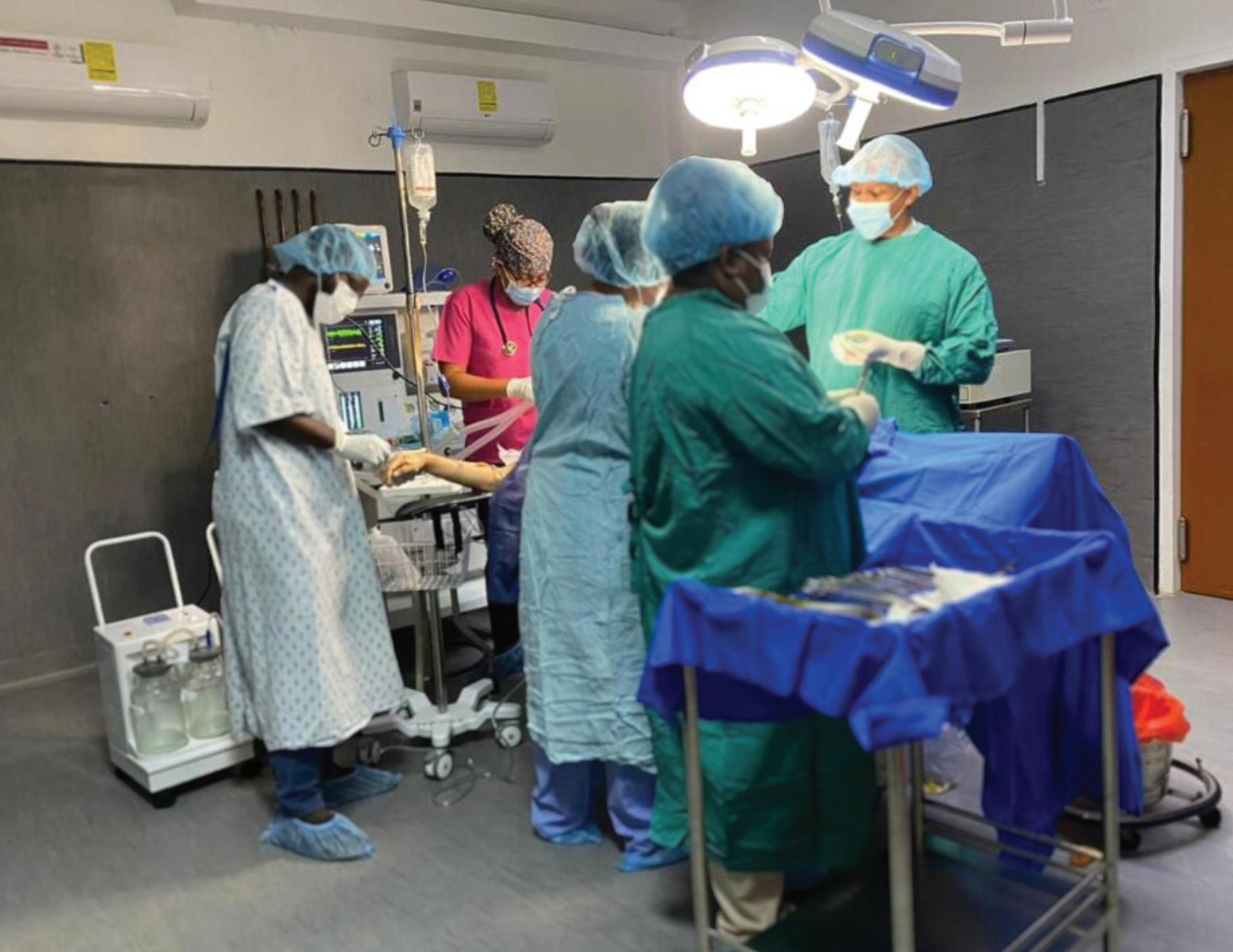
EUROPEANS first came to these parts on ships with red crosses on their sails, carrying men with weapons blessed by The Vatican and crosses and rosaries hanging around their necks, while they massacred the Indigenous people who welcomed them.
They came with the Pope’s blessings under the Doctrine of Discovery –decreed in Rome 500 years ago this year - that gave them a holy right to kill in the name of God.
Pope Francis of Argentina – the first non-European Catholic pontiff and from one of South America’s many nations where Indigenous people have survived - earlier this year, denounced the Doctrine of Necessity that saw all that killing in the name of Christ.
But that does not erase the fact that Caribbean peo-
ple and their counterparts in The Americas still don’t have near-enough knowledge of who their First People really were, how they lived and sustained life, culture, and religion before the European arrival.
One long-lasting untruth has it that Indigenous people are only ‘Amerindians’ (American Indians), but there were also native people of African descent in these parts before the Europeans arrived, as Guyana’s Professor Ivan Van Sertima proved in his epic 1976 book entitled ‘They Came Before Columbus’.
According to the Amazon promo advertising Van Sertima’s book: “This book makes it possible for us to see clearly the unmistakable face and handprint of Black Africans in Pre-Columbian America, and their overwhelming impact on the civilization they found here.”
The shared (African and Indian) history of the Caribbean’s First People is very much alive in Saint Vincent & The Grenadines, where the Garifunas were rounded up and banished into exile in Central America, where they now populate Belize, Guatemala, Honduras, and Nicaragua, in numbers several times the size of their original Caribbean motherland.
Today’s descendants of the Callinago (Yellow Caribs) and the Garifuna (Black Caribs) are distinct races within the mixed Vincentian population.
Unfortunately, we know more about ‘Latin America’ than the history and civilizations of First People that were almost made extinct, but which continue to survive today.
As far back as April 2014, following CARICOM’s announcement of its initiative to seek rep -
arations for Slavery and Native Genocide from the UK and European nations that benefitted from the Slave Trade, the Caribbean Organisation of Indigenous Peoples (COIP) welcomed the move as one also being important to Caribbean First People.
In December 2013, the CARICOM Reparations Commission (CRC) noted that “Caribbean societies also experienced the genocide of the native population, which was also declared a crime against humanity by the United Nations.”
It added, “The victims of these crimes and their descendants were left in a state of social, psychological, economic and cultural deprivation and disenfranchisement that has ensured their suffering and debilitation today, and from which only reparatory action can alleviate their suffering.”
The COIP welcomed the initiative because it also seeks Reparations for Native Genocide, as descendants of the original inhabitants still live on the Caribbean islands within CARICOM.
COIP comprises membership from Belize, Dominica, Guyana, Suriname, St. Vincent & The Grenadines and Trinidad and Tobago and says it stands ready to play a role in building strong arguments on the Caribbean condition of the descendants of Native Peoples and in favour of reparations for evils inflicted on them.

It plans to ask the Caribbean Development Bank (CDB) to fund a project to preserve and promote the use of Indigenous languages – and tap into the training expertise of First People in Guyana and Suriname, to retrieve indigenous Caribbean languages
where they have been lost, as they still speak their indigenous tongues that have survived centuries without formal schooling, thanks to oral history traditions.
The revival and preservation of the indigenous Caribbean languages was indeed among several ideas discussed at the CDB’s special forum for Indigenous peoples held on the sidelines of its recent 53rd Annual General Meeting in Saint Lucia in June.
The CDB promised to collaborate with Indigenous peoples in the Caribbean, to issue statements on August 9, the United Nations-designated International Day for Indigenous Peoples. Here’s hoping CARICOM will follow the regional bank’s timely lead to help put reparations for Native Genocide in its proper context for equal action.

During its three years in government, the PPP/C has led an aggressive development agenda aimed at delivering on manifesto promises to the people of Guyana.
The Ali-led government campaigned on a very ambitious manifesto and has worked tirelessly during its time in office to deliver on these promises.
The PPP/C Government is being lauded by many as a proverbial “breath of fresh air” following the APNU/AFC's
stint in office that was marred by their inability to deliver on campaign promises.
The APNU/AFC now forms the main opposition and has demonstrated to many their tenacity to anti-agents of development.
Their constant race-baiting and propaganda spreading seek to undermine the president's drive to unite and develop the country under his “One Guyana” mantra.
The People of Guyana are, however, not fooled as we continue to witness the unfolding of the govern-
ment’s massive development agenda.
The government is three years in and is well on the way to delivering on all campaign promises on issues such as employment, housing, health care, and education.
The robust public infrastructure improvement plan continues to impress the masses as many enjoy the bounties of the improved road network while awaiting development such as the new Demerara Harbour Bridge
In addition to delivering on campaign promises
the PPP/C government is also working to finish works started and failed under the APNU, and further correcting the coalition’s many atrocities.
Since taking office, the government had to undo the many taxes imposed by the previous government to ease the burden on Guyanese while providing cash grants and other such assisting programmes to rescue the people from the hardships imposed by the previous government.
In a recent interview, the Prime Minister boasted of works done to improve

hinterland.
In the same interview, he spoke of the fact that the government was able to actually liberalise the telecommunications sector, something that the opposition campaigned heavily on before taking office in 2015 but failed to deliver.
As a proud son of the soil, I have nothing but commendations for the government and its efforts at improving the lives of the people of Guyana and bringing large-scale development to local shores.
We appreciate the President and the Cabinet for not insulting our intelligence with half-baked schemes and political language, but actually developing projects and programmes to improve the lives of all Guyanese.
We thank the government for a progressive and successful three years and look forward to many years of continued success under the stewardship of President Dr Mohamed Ali.
Yours truly, Alvin Hamilton
IN the context of Indigenous Peoples’ Day, it is imperative to reflect on the confluence between environmental preservation, the emergence of the bioeconomy, and the intrinsic rights of Amazonian indigenous peoples and rural communities.
This vast green lung, which covers 6 million km2 and embraces nine nations, is considered one of the most biologically diverse areas on the planet. About 10 per cent of all plant species are found in this region, including more than two thousand species of fish, 14,000 species of plants, and about 1.5 million species of fungi.
However, the Amazon is facing unprecedented threats. Projections suggest alarming deforestation by 2030, with economic and ecological impacts that could translate into more than US$230 billion in
losses, according to the IDB. This problem is global.
Antonio Guterres, Secretary General of the United Nations, stated that the era of global boiling has arrived. This alarming statement was issued after scientists indicated that July 2023 was on track to become the hottest month ever recorded in the world. And the fact is that, by any scientific calculation, the possibility of stopping the global temperature rise to 1.5ºC (above pre-industrial levels) requires a healthy Amazon rainforest.
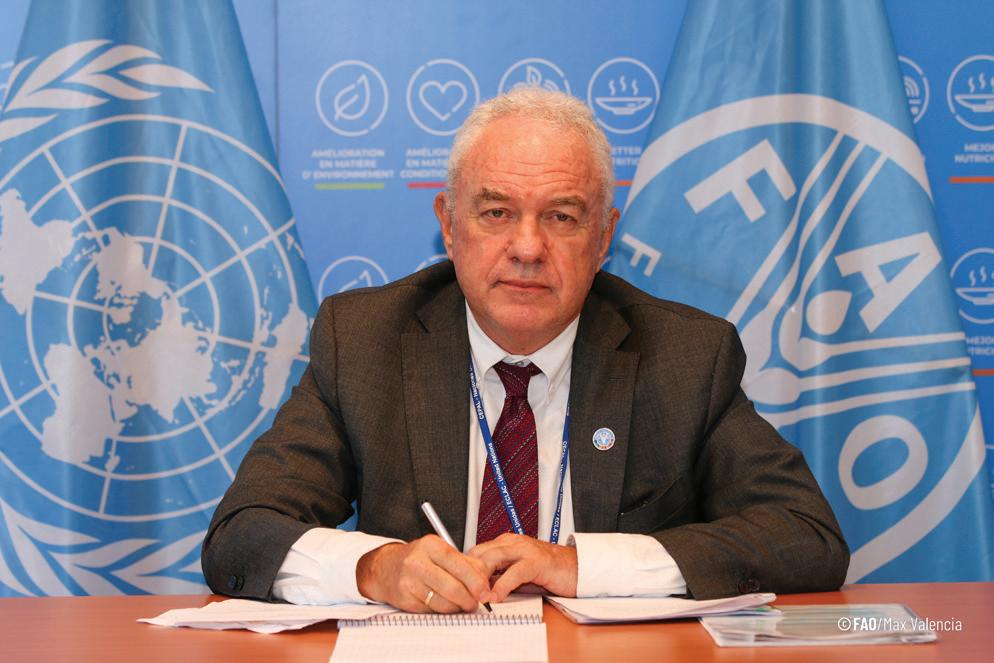
Amid this complex panorama, a glimmer of hope emerges. The Amazon’s indigenous peoples and rural communities are rooted in their deep ancestral knowledge. They hold the key to a sustainable transformation in a symbiotic relationship with the forest.
The indigenous peoples
and rural communities of the Amazon live in regions of vast biodiversity and preserve ancestral knowledge essential for protecting and revitalising the Amazon biome. In addition, they possess a crucial productive capacity that ensures food and nutrition for a growing urban population. However, despite their invaluable contributions, they face significant challenges like poverty, violence, unemployment, and hunger.
Approximately 45 per cent of the Amazon basin’s intact forests are in indigenous communities’ hands. Furthermore, between 2003 and 2016, vegetation in indigenous territories in the Amazon basin sequestered about 90 per cent of the carbon emitted from deforestation and forest degradation in those same territories. This means that these territories have significantly contrib -
uted to reducing net carbon emissions while preserving the Amazon rainforest.
To bring a renewed Amazon bioeconomy to life is crucial to honour the rights of indigenous peoples and all other communities, women, youth, and family farmers. Despite their differences, they all share a common goal: preserving the Amazon.
The consolidation of an equitable and collaborative Amazonian bioeconomy requires the implementation of policies that divert investments from actions harmful to the forests, the strengthening of co-operation
among Amazonian nations, a detailed understanding of the interactions between rural and urban areas, and the creation of solid platforms that integrate ancestral knowledge with the latest scientific and technological advances.
The role of indigenous peoples and rural communities in this bio-economic metamorphosis is irreplaceable. They are the ones who not only guard the forest but also decipher and harness its resources with a sustainable perspective, crucial for global food security and agri-food
systems that promote better nutrition, a better environment, better production, and a better life, leaving no one behind.
Protecting the Amazon and enacting an inclusive bioeconomy transcends borders. It is a universal call. On Indigenous Peoples’ Day observed on Wednesday, we reaffirm our commitment to Indigenous peoples and Amazonian rural communities in their aspiration for an equitable and resilient future.
I’ve noted a Demerara Waves Online news report on August 7, 2023, which quotes an unnamed People’s National Congress Reform (PNCR) official as giving a lack of funding as the reason for the one-year delay in the holding of a meeting of the party’s second highest decision-making body.
If this report is true, I find it hard to believe.
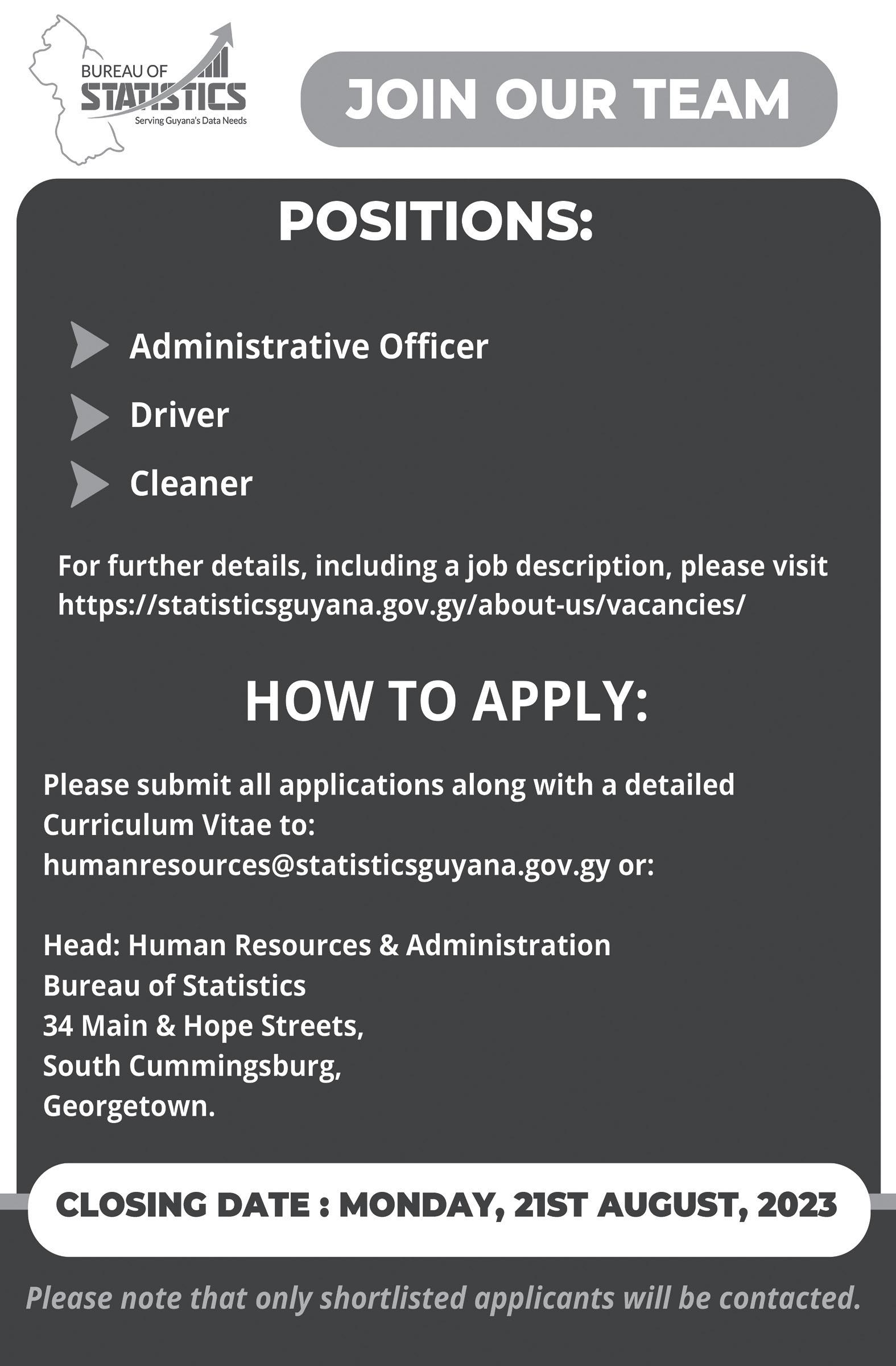
In a Demerara Waves article on July 27, 2023, it was reported that Mr. Norton was questioned on whether or not his party received funding from ‘Mohameds’ and whether it would accept the same in the future.
Norton refused to say whether or not the party would accept future donations, stating that “it was not wise to name party financiers, as they risk being punished by the government in areas such as the award of contracts.”
By Mr. Norton’s own admission, the PNC is not short of donors. One is, therefore, left to wonder how the party is now unable to mobilise the $2.4 million needed to host this critical General Council meeting.
Is there something sinister afoot?

Is someone in the party’s leadership afraid of having their performance so far being subjected to the scrutiny of the wide membership?
Sincerely,
Ryan NewtonIs the excuse of insufficient funds deliberately intended to stymie an integral aspect of PNC’s internal democratic process?
“We must all, regardless of political affiliation, work together to improve services to communities. There are no winners when communities and public assets are neglected or fall into decay. I offer a hand of friendship and support to all Local Government bodies. Central Government stands as a partner in development.”
Resounding and resolute words from a remarkable President, Dr. Mohamed Irfaan Ali, as he unswervingly
implored the new batch of sworn in mayors and their deputies to put the interest of the people and nation first and come on board with his administration’s aggressive developmental agenda, while not allowing their political affiliation to come in between.
Many had debunked the former PNC administration for their monstrosities and atrocities during their 20152020 tenure, more so, when the party was tasked as being a caretaker government only and restricted in dealing with financial transactions.
On the contrary, they went on a “holiday spree” giving out lands to their cronies and wheeling and dealing with the nation’s assets. One of the early dissents was former Minister of Business, Dominic Gaskin, ex- President Granger‘s son-in-law, who was very adamant and refused to be influenced by the skullduggeries of the PNC Government.
Mr. Gaskin could not hide the truth by remaining quiet and polite, “while our country gets hijacked, ridiculed and torn apart.”
In a March 2020 message

to his colleagues, he reminded them that they were not elected to remain in office forever and they need to, “level with your supporters and start directing your energies towards becoming a credible opposition party in time for 2025.”
He further stated what was as clear as daylight, ‘supporters of the APNU+AFC were misled into believing that the coalition had won the election.’
Since the PPP/C Government took office three years ago, President Ali and his Cabinet members have committed themselves in words, deeds and actions to dedicate their resourcefulness to help build a better Guyana and remove the stigma of negativity, distrust and corruption which plagued the nation under the PNC’s devious reign from 2015 to 2020.
No wonder shortly after President Ali was sworn into office on August 5, 2020, Guyana was honoured with a visit from then United States Secretary of State, Mr. Mike Pompeo.
From day one, the PPP/C Government has been working assiduously to improve living conditions in Guyana and to repair the international image of the country, besmirched by the callous PNC governance.
It is no small task for Guyana to earn and maintain the respect of the United States and for the second time during the same Government, to host the Secretary of State. In July 2023, Mr. Anthony Blinken stated in his remarks to President Ali, “The United States appreciates the increasingly significant role that Guyana is playing in addressing regional and indeed global issues: a leader on the Inter-American Commission on Human Rights; and, of course, starting in January, one of the new term mem-
bers of the United Nations Security Council.” Under the mantle ship of the PPP/C Government and President Irfaan Ali’s leadership, Guyana is quickly regaining lost grounds both economically and socially.
The country is globally recognised as the world’s fastest growing economy with a GDP which increased by 100 per cent over the past two years.
Inheriting a bankrupt economy from the wasteful PNC Government for the second time, Outsource Asia had this to say about the PPP/C management of the country’s finance: “Powered by the rapid economic growth, President Ali has led Guyana through a period of rapid transformation, and the government has laid out a masterplan for rapid development and transformation. Moreover, they have demonstrated our ability to work tirelessly to make this vision a reality so that citizens can reap the benefits as soon as possible.”
No wonder President Ali is asking all stakeholders to join the Government’s winning formula for developmental success!

Despite winning over 80 per cent of the NDC and municipality seats at the recent Local Government Election, the ever-simple President Ali allows his humbleness and humaneness to override any ego and reach out to each leader, not identifying with any indifferences but embracing them with fraternity and to look each person straight in the eyes, extending his warm hands in friendship.
The President’s comradery reflects his genuineness and those present did well to reciprocate and “shake the hand that shook the world.” They did not follow the haughtiness of Leader of the Opposition, Aubrey Norton.
In fact, they allowed common sense to prevail and took the opportunity to make the right choice of wanting to start fresh by being on the right side for society.
President Ali has during a short span of time, met scores of world leaders who unhesitatingly and lovingly open their arms to embrace him affectionately.
This close friendship was earned through honesty and integrity and not demanded via fear or fame!
The PPP/C Government is laboriously making perpetual outreaches to all Guyanese. Prime Minister, Brigadier (Ret’d) Mark Phillips recently said in the National Assembly: “We (PPP/C) have a holistic plan that we have been delivering to the people of Guyana. We are a people-centred government.
“Unfortunately, the entire opposition cannot keep abreast with what is happening around them. But those who have eyes to see will see, and those who have ears to hear will hear. The people are seeing, and the people are hearing, and the people have started to ignore you (The Opposition).”
How appropriate that during the recent Emancipation Day celebration, no other than Dr. Richard VanWest Charles, son-in-law of former President Forbes Burnham, should honour President Irfaan Ali!
He said: “Guyana under the leadership of President Ali is currently on an upward trajectory of building a strong future… We have multiple ethnicities, and we have in our motto, ‘One people, One nation, One destiny’ and the president’s programmatic framework of ‘One Guyana.’ That is important for us because it is building a nation.”
Yours respectfully, Jai Lall.
goal of the LCDS 2030.
IN his quest to ensure that the country continues to have a significant international voice on environmental protection and climate security, President Dr Mohamed Irfaan Ali, met with 13-year-old Ismachiah Oduwole, a footballer from California, USA, who is also playing his role in contributing towards climate action and environmental advocacy.
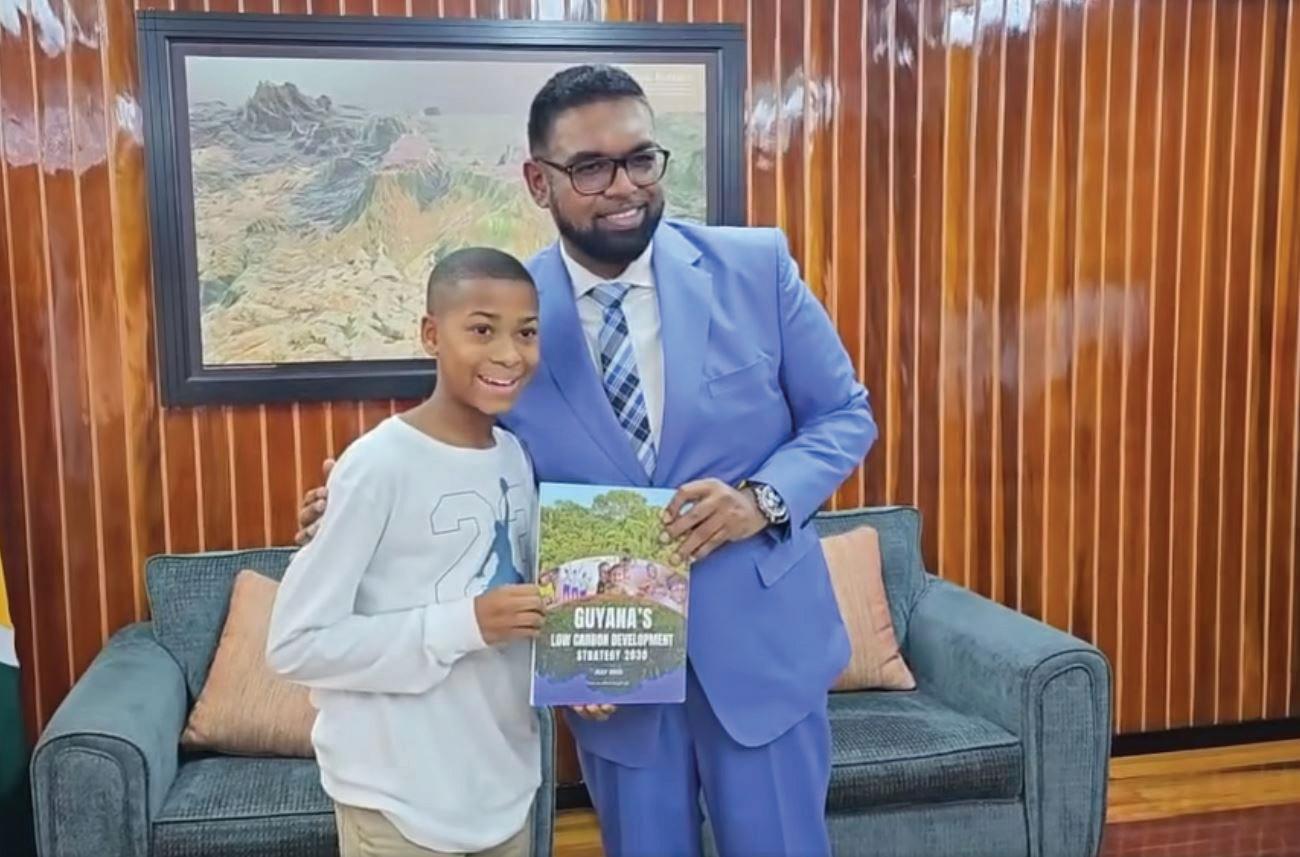
During their meeting, the President commended the young activist for his initiative and shared with him, facts about Guyana’s forest. According to President Ali, “the forest that we have is a part of the Amazon Forest, and it stores 20 per cent of the world’s oxygen. Our forest is the size of England and Scotland combined; it stores 19.5 gigatonnes of carbon, and 15 per cent of all the revenues that we earn on the carbon sales go directly to the Indigenous People, which are the first people of the country. The revenue goes towards them to help them directly with their livelihood.”
In an exclusive interview with the Sunday Chronicle, Ismachiah explained that the main reason for his visit to Guyana was to meet and have a conversation with President Ali about climate change.
According to the young activist, “my visit with President Ali was great; I told him about my mission and what got me into it. Apart from that, President Ali fa-
cilitated a tour of Guyana’s rainforest, where I got to see the largest single-drop waterfall in the world, the Kaieteur Falls. I also got a chance to see the lush green forest. I would like to thank him for the experience.”
He continued, “there are four reasons why I picked Guyana: the first reason is that Guyana is selling carbon credits because of its large rain forest, the second reason is that by selling carbon credits, Guyana is slowing down deforestation; and it is also contributing to absorbing carbon dioxide.
“My third reason is that Guyana has a full-proof programme for the citizens so that they can learn about the cause and prevention of climate change. The fourth and final reason why I chose Guyana is because Guyana is exploring hydroelectricity, which is when water is used to produce electricity.”
While he may be passionate about having a cleaner and better world for mankind, the 13-year-old activist took the opportunity to speak to the people of Guyana, especially the children, saying, “It doesn’t matter how old you are, you can make a difference.
Ensure that you dispose of your garbage properly, and a simple gesture can go a long way. We can all make the world a better place. I went to Africa with my family, and I saw single-use plastic on the floor, and I thought to myself that the plastics were supposed to be in the
deforestation has been at its lowest. Guyana recorded a 0.036 per cent deforestation rate in 2022, which, as the President noted, was independently verified by remote sensing technology, and ground assessments.
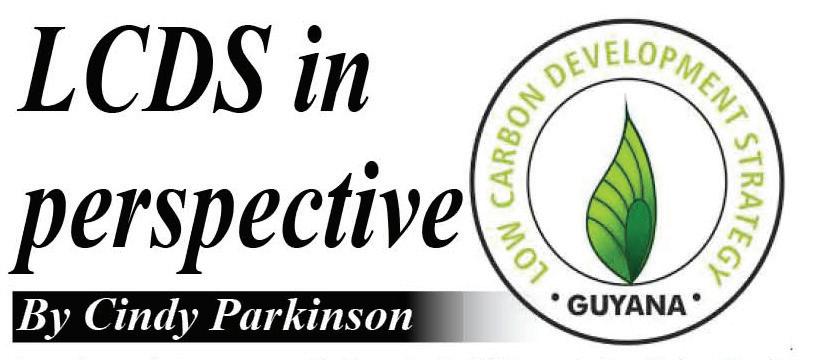
trash and not just lying there. That’s when I decided that I wanted to do something to protect the climate and the earth.”
Guyana continues to be a pioneer in the world for forest management because of the strategic vision of the LCDS 2030, which is producing tangible results for the climate financing programme. The nation’s historic issuing of the first jurisdictional-scale carbon credits was highlighted by the president during one of his press conferences in July, at the Office of the President in Georgetown.
According to the President, Guyana will receive US$750 million from the sale of carbon credits for the years 2016 through 2030, with US$150M already received from this total. He also pointed out that the hinterland will receive 15 per cent of the revenues from the carbon credit programme, in addition to the coastland, as a result of the climate funding programme, with 242 Amerindian villages already receiving a total benefit of $4.7 billion from this. President Ali further explained that over 200 villages have already submitted their village plans, and they are all in varying phases of execution, adding that more than 85 percent of the country’s forest is still intact as evidence that the administration is committed to protecting the environment.
Additionally, since 2010, the nation’s rate of
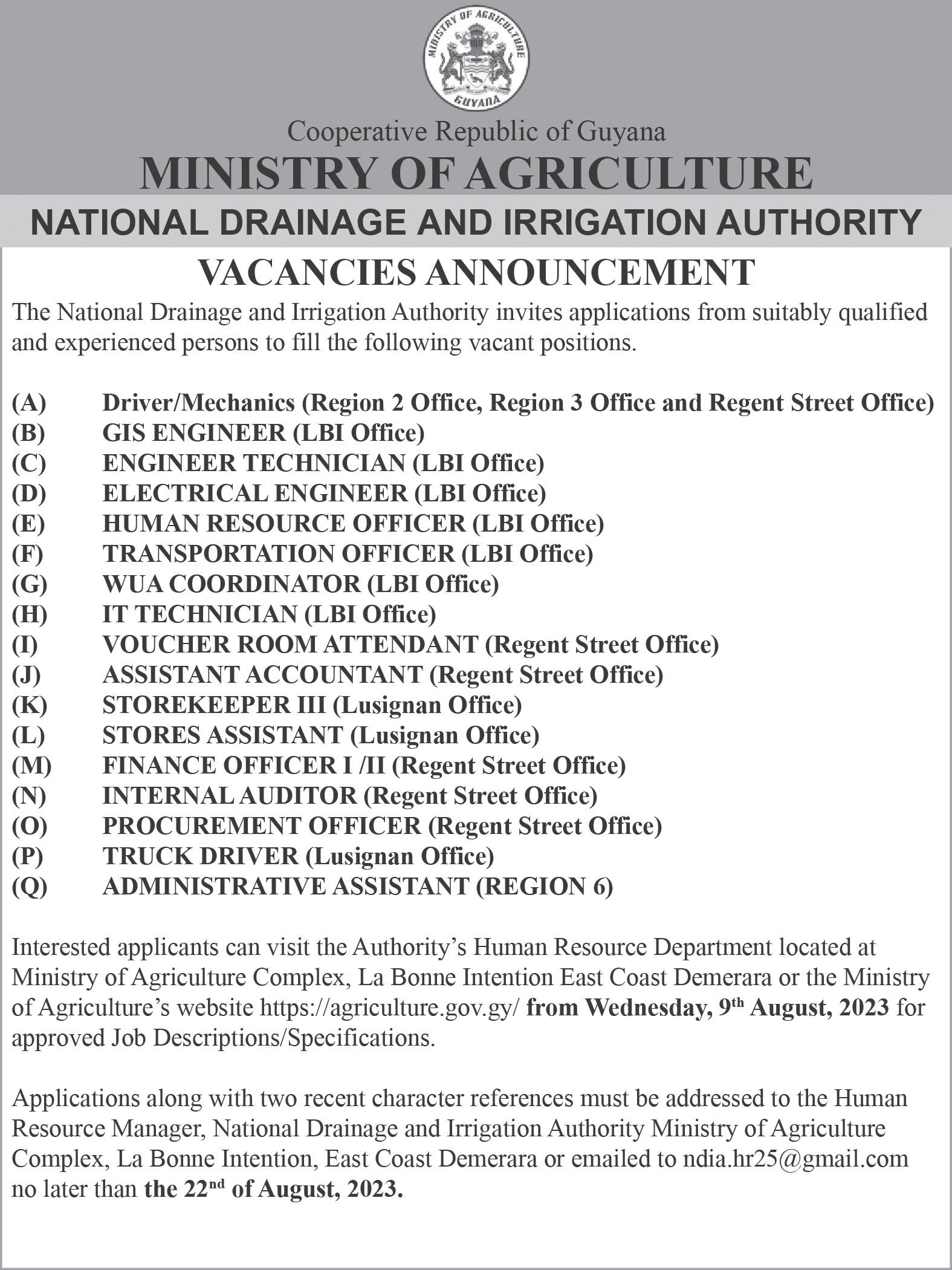
“Even with Guyana’s accelerated development in all corners of the country, we have not only maintained forests, but we have further strengthened our progress in this area,” the Head of State noted.
The President emphasised that the nation has also been able to maintain its status as a net carbon
sink, which indicates that it takes in more carbon annually than it emits, noting that even as its oil and gas industry grows and ten floating production, storage, and offloading (FPSO) boats are currently operating offshore, the nation maintains this position.
President Ali made the significant observation that 154 million tonnes of carbon dioxide are annually removed from the atmosphere. To further add to this, Guyana has made tremendous advancements in its switch to clean and renewable energy sources, which is a key
According to him, “Guyana’s energy security is bolstered with the signing of the contract for the gas-to-energy project,” the president stated. “Guyana’s largest project to date, the project will add 300 megawatts of new power and cut electricity costs by 50 per cent.”
The President also referred to the quick adoption of solar off-grid systems in Berbice, Linden, and Essequibo. The proceeds from the $85 million in bilateral co-operation between Guyana and Norway will also be used to finance 33 megawatts of solar energy. The gas-to-energy project, which is anticipated to start producing electricity by the end of 2024, is anticipated to revolutionise the ease of doing business in Guyana.
PRIME MINISTER, Brigadier (Ret’d), Mark Phillips, has called on states within the Amazon region to pursue a robust agenda and find viable solutions to combat challenges, underscoring that environmental protection must not translate to the absence of development in the respective countries.
Prime Minister Phillips made the remarks at the opening of the Amazon Cooperation Treaty Organization (ACTO) in Belem, the capital of the Amazon state of Para, Brazil.
The leaders of eight South American nations that share the Amazon rainforest are a part of the meeting with the objective of reaching a broad agreement on preserving the critical region.
“If we continue on our current trajectory, the prognosis offers no relief in sight. The status quo of the environment is clearly on a downward spiral, and it is in the interest of future generations that a concerted effort be made to arrest the situation,” he highlighted.
In his address, he underscored the importance of the Amazon rainforest and said it plays an invaluable role in climate fight. The rainforest described globally as a “carbon sink” has the ability to easily absorb pollutants from harsh emissions.
According to the Prime Minister, the challenges of illegal forest activities, deforestation, and forest fires, threaten the delicate equilibrium of the basin and the livelihoods of indigenous and other communities. There-
fore, the states that are part of the Amazon must bear the responsibility for safeguarding this invaluable natural resource for the benefit of current and future generations, he stressed.
“We must be resolute in our efforts to combat these threats and to ensure that our initiatives under the ACTO cooperation programme have a strong focus on the sustainable management of forests, forest preservation and forest conservation,” the Honourable Prime Minister said.
During his address, Prime Minister Phillips reminded South American leaders of Guyana’s dedication to preserving and conserving the environment. He emphasised that Guyana is committed to playing its part in the fight
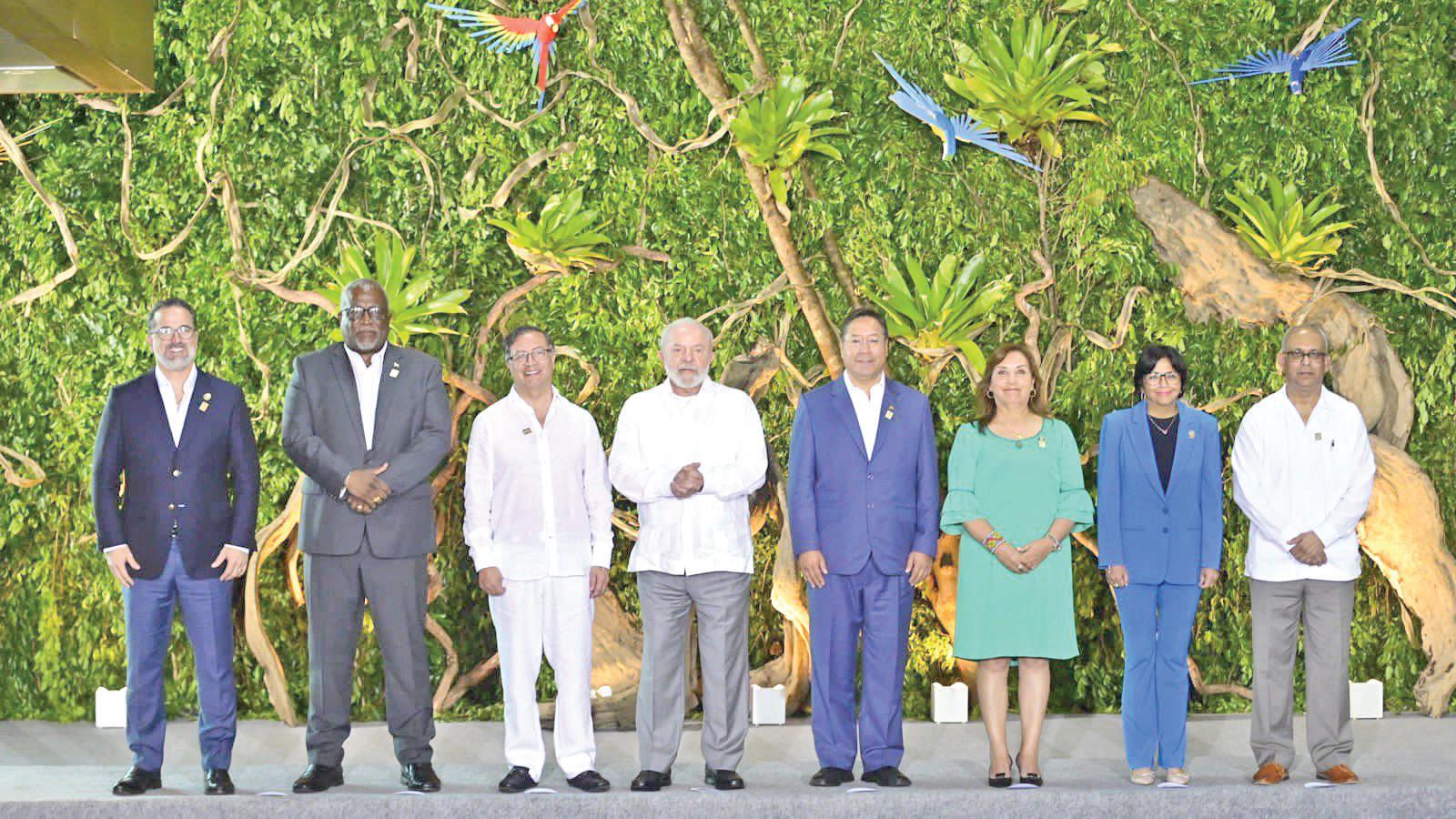
against climate change.
“In keeping with our commitment to the sustainable development of our natural resources, Guyana, as an emerging oil state, continues to direct its efforts towards the diversification of its energy portfolio to include renewable energy sources,” he assured.
Further, the Prime Minister stated that indigenous people have shared a sacred relationship with the land and the forest. As he charged leaders to include indigenous people and voices in the development process, he explained that, “It is therefore imperative that they continue to play an integral part of the ACTO sustainable development mechanism,”
Prime Minister Phillips
also highlighted that indigenous communities continue to play an invaluable role in the protection and preservation of the Amazon region, noting that, for generations, they have depended on the Amazon for food, shelter, medicine and livelihood.
“Their traditional knowledge continues to be of great value to the preservation of the Amazon region,” he added.
Prime Minister Phillips further stated that the Summit must bring to bear the awareness of the great urgency with which the international community needs to reconcile its commitment to the world we live in. The efforts must be with equal fervour as large countries did two years ago when the COVID pandemic reordered
our lives.
“The States of the Amazon must raise our collective voice and develop strategic partnerships that will ensure that the commitments made during those deliberations are realised for our mutual benefit,” the Prime Minister added.
He said too, that the Amazon states must remain united for the forests and continue to advocate for the adoption and implementation of Jurisdictional and Nested REDD+ Frameworks within voluntary and compliance market-based structures.
This, he said, “can catalyse climate finance, information exchange, expertise sharing, and collective problem-solving, fostering a united effort in addressing
climate mitigation and adaptation goals at the regional level.”
Advanced policy pathways for High Forest Low Deforestation countries and jurisdictions with high carbon ecosystems, such as mangroves, peatlands, mature forests and marshes to access climate finance must be a part of the discussions, not only at this summit but also at the upcoming CoP 28, in Dubai, United Arab Emirates.
He emphasised that, as part of ACTO’s role in promoting regional cooperation and sustainable development in the basin, work must be done to quickly strengthen collaboration and implement innovative initiatives to protect the region’s natural resources.
This objective, the Prime Minister noted, can be achieved by bolstering ACTO’s structure and empowering its various mechanisms.
“We can collectively pave the way for a more resilient and prosperous future, ensuring the preservation of our shared ecological heritage.”
“Let us seize this historic opportunity as leaders of countries responsible for the Amazon rain forest to demonstrate our determination and resolve in tackling the environmental challenges and forging a sustainable, equitable future for all,” the Prime Minister said as he urged leaders to be committed to the cause.
ACTO’s member nations are Bolivia, Colombia, Ecuador, Guyana, Peru, Suriname, Venezuela and Brazil.
According to the Guyana Defence Force (GDF), the three-weeks course, which aims to prepare the ranks to effectively and efficiently employ doctrine and drills at the Gun Team level in the execution of any artillery/support missions across the full spectrum
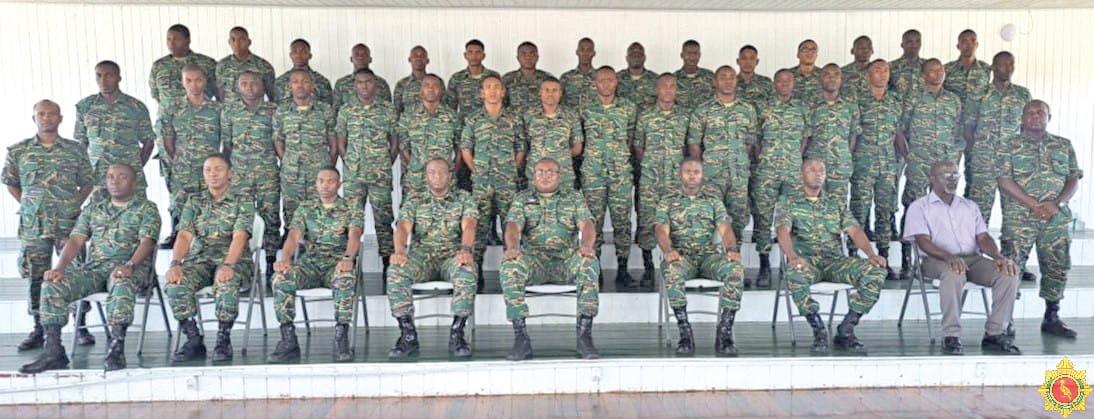
of military operations, is scheduled to conclude on August 16, 2023.
The successful conduct of the course will see the ranks being exposed to several subject areas including, but not limited to, Shot Theory, Tactical Employment, General Knowledge, Map Read-
ing Navigation, Ordnance Science, Surveying, Firing Service, and Signals.
Additionally, the course is scheduled to culminate with a Live Firing phase. During this phase, a series of Live Firing Exercises will be conducted with the artillery and support weapons.
THIRTY-SIX ranks are currently undergoing training on the Grade Three Artillery and Support Weapons Course, 2023The ranks currently undergoing training along with other senior ranks (seated) and trainers
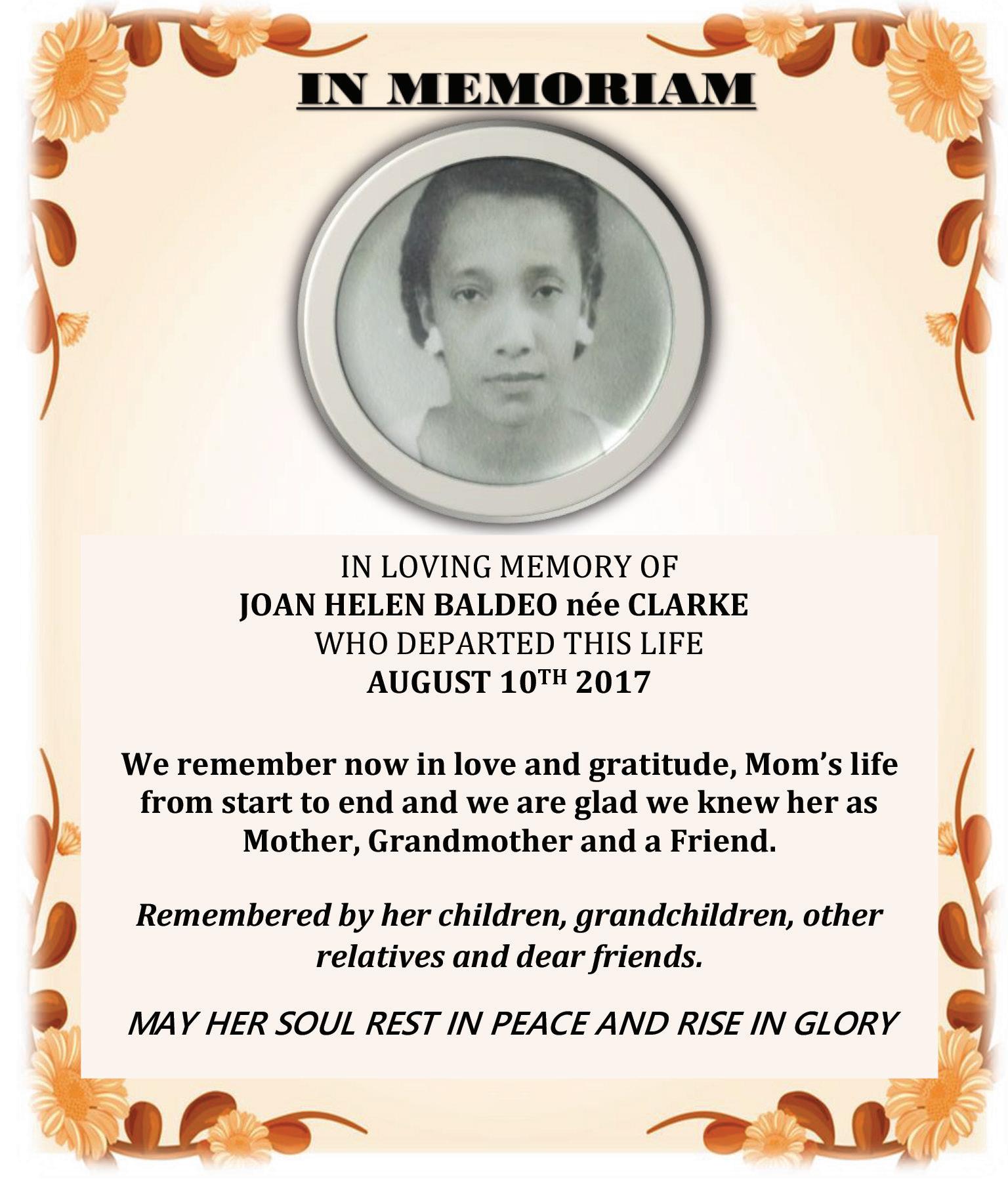
DECLASSIFIED documents change the way we see history because they reveal things we did not know before. Declassified documents this week compel the world to think about the possibility that Henry Kissinger should be charged for war crimes committed in Chile in 1973.

But those documents not only show the role of Kissinger and President Nixon in planning the overthrow and killing of an elected president in Chile, but the role of the private media in the coup.
The recent released documents revealed Nixon summoned the owner of the anti-Allende newspaper, El Mercurio, Augustin Edwards to Washington, DC to plan the prevention of Allende from being inaugurated.
El Mercurio was hostile to Allende and was vicious in inciting violence up against Allende.
The released papers are a goldmine for those researching the praxis of Cheddi Jagan. Readers are given information on the role a newspaper played in the removal and assassination of an elected president. Edwards
as part of the conspiracy requested ammunition and money from the Americans for the removal of Allende.
Can one imagine a newspaper which is traditionally accepted as one of the safeguards of freedom, liberty and justice was intimately involved in the planning of a coup?
It happened in 1970 in Chile, but 10 years before it happened in a country named British Guiana (BG) against an elected premier named Cheddi Jagan. It is possible that El Mercurio studied the modus operandi of four privately owned anti-Jagan newspapers in BG in its quest to topple Allende?
Throughout his political life, Jagan had pontificated extensively on the anti-working class role the private media had played in the disturbances of the 1960s that led to his removal from government.
But he also warned us about the dangers of reactionary newspapers in the world. Jagan carried the belief all his life that private newspapers can have their own anti-government agen-
da because he saw that agenda in BG from the time he was elected in 1957 to the time he was removed in 1964.
It is a nasty and sick vulgarization of political theory to assert that the media is a sacrosanct institution whose role is to safeguard society from dictatorship.
Maybe the press started out with that goal thus earning the name, the Fourth Estate. When you look at Fox News in the US, and the Stabroek News and the Kaieteur News here, it becomes a sick joke to refer to the press as the Fourth Estate.
Let’s quote Barack Obama. Asked about what keeps him late at night, Obama told CBS: "The thing that I'm most worried about is the degree to which we now have a divided conversation, in part because we have a divided media, a splintered media.
“Today what I'm most concerned about is the fact that, because of the splintering of the media we almost occupy different realities, right?”
Which country is Obama talking about when he refer-
enced, “different realities?” It is the USA of course, but his reflection also applies with enormous force to Guyana.
The Stabroek News ran an editorial on the attainment of three years in office by President Ali and found that the three years were a failure with no achievements.
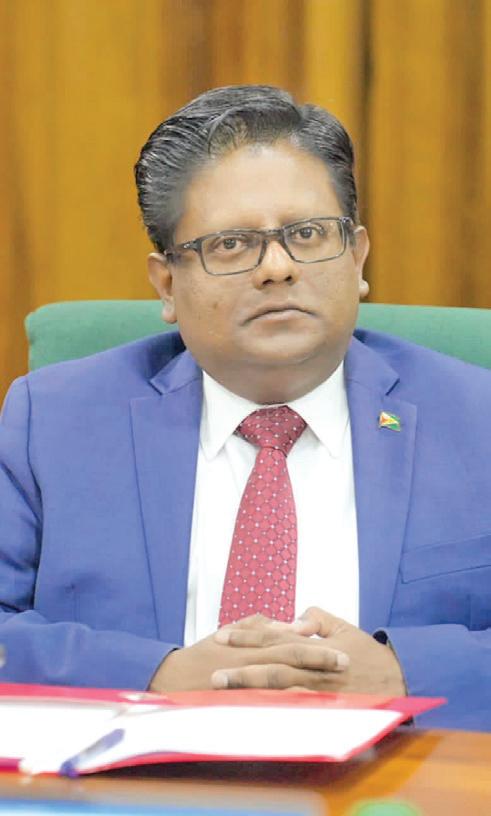
It was a grotesque, ugly and debauched assessment of the realities in Guyana, where a popular president has achieved more goals than any of his predecessors in the first three years in office.
A New York Times-Siena College poll published in October last year found 59 per cent of voters view the media as a
“major threat to democracy,” while 25 per cent said the press is a “minor threat.”
The annual Gallup survey also published in the same month last year found only 34 per cent of Americans believe major news organisations will report “fully, accurately and fairly” on current events
Nearly three-quarters of US adults say the news media is increasing political polarisation in the US, and just under half say they have little to no trust in the media’s ability to report the news fairly and accurately, according to a new survey from the Associated Press-NORC Center for Public Affairs Research and the Robert F. Kennedy Human
Rights organisation. The result of the survey was released in May of this year.
In Guyana, it seems we are returning to an evil period in newspaper history; the period in which the newspapers were in open political hostilities against the PPP government from 1957 to 1964. By some strange, twisted logic, Guyana is returning there.
But the results will be different of course. The Guyanese people will not be easy preys in the 21st century. The LGE 2023 results show that the Guyanese people will reject the El Mercurio mentality of Stabroek News and Kaieteur News.
TO ensure a stable of electricity supply, the government is seeking over $927 million to assist the Linden Electricity Company in Region 10 and the Lethem Power Company in Region Nine.
Senior Minister in the Office of the President with Responsibility for Finance, Dr. Ashni Singh, said that the amounts provided are to offset the increase in fuel prices and consumption, as well as the increased cost of delivery.
He made the statement during Wednesday’s sitting of the National Assembly as it debated the government’s request for $61 billion supplementary funding, which is expected to finance additional development priorities.
Some $663 million is being sought for the Linden Electricity Company and over $264 million is expected to support the Lethem Power Company.
“The additional appropriations that are being sought reflect additional costs that are being incurred as a result of both increased consumption, increased fuel costs, and additional support for things like maintenance at these two companies to ensure that both Linden and Lethem continue to re-
ceive electricity as we have committed to delivering to them,” he explained.
These sums represent a current best estimate of the companies’ additional financial requirements for the remainder of the year.
“We will remain closely engaged with the respective companies to ensure that they continue to manage their operations efficiently. We will also remain closely engaged with the communities,” the minister assured.
While pointing out that these allocations are not directly related to a possible reduction in the rate of
electricity, the finance minister noted that government continues to invest heavily in improving electricity production and generation.
He highlighted several ongoing projects aimed at achieving this including the Gas to Energy Project, the rehabilitation of the Moco Moco Hydropower plant, and the installation of solar farms in Linden, in keeping with the Low Carbon Development Strategy.
“The task of improving increasing electricity supply and improving the quality of that electricity and the cost, is a task that government has applied itself to across Guyana, including Regions Nine and Ten,” the senior minister told the House.
These funds for the Linden Electricity Company and the Lethem Power Company form part of a $5, 093, 359 500 amount being sought for the Office of the Prime Minister to advance power generation and data management activities.
The allocation is also expected to fund the provision of additional resources to support the Gas to Power project, as well as to support the expanded work programme of the National Data Management Authority (NDMA).
GUYANA will soon be positioned to become a supplier of agro-chemicals and the country has already set its sights on a lucrative market in Brazil.
On Tuesday, during a bilateral meeting in the Dominican Republic, representatives from Guyana’s private sector signed several Memoranda of Understanding MoUs; one of the agreements is for the establishment of a petrochemical plant in Guyana.
President Dr. Irfaan Ali
who led the private sector delegation at a conference shortly after the agreement was signed said that once the project comes to fruition, Guyana could supply agro-chemicals to its neighbouring country Brazil.
“Northern Brazil is a high consumer of agro-chemicals and they require it from all over the globe. It would take them a very long time for transport and logistics. With an investment like that in Guyana, in 48 hours, we can be in the market,” Ali said.
Agrochemicals are pesticides, herbicides, or fertilisers used for the management of ecosystems in the agriculture sector.

The agro-chemical market in Brazil was valued at US $13.5 billion in 2019.
Outside of the petrochemical plant, Guyana also inked agreements for the establishment of an oil refinery, and a study for participation in Guyana’s Oil Exploration Block and co-operation in the tourism and agriculture industries with its DR coun-
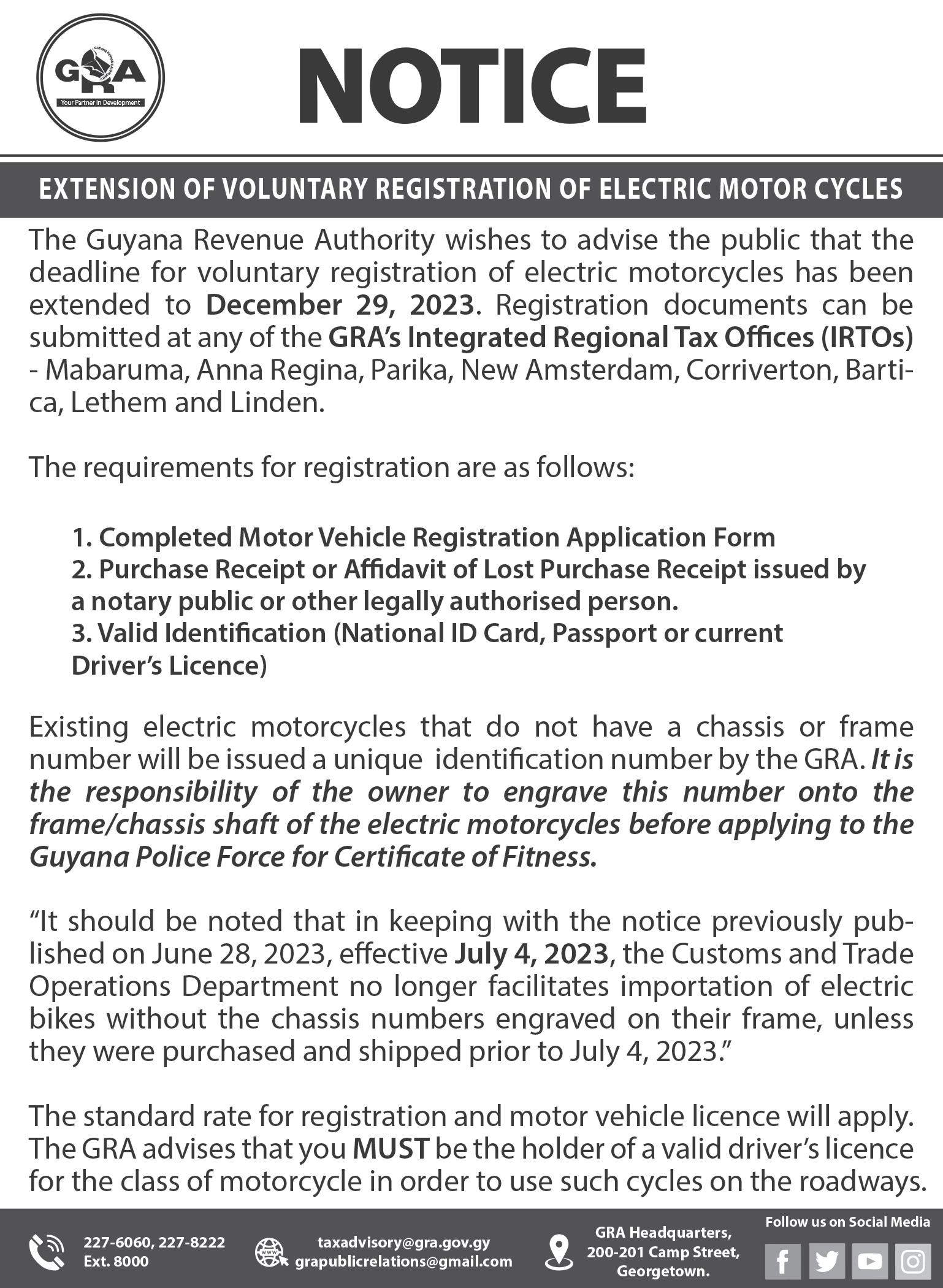
terparts.
According to President Ali, as the two countries continue to solidify their partnerships, the people of the respective nations are set to benefit.
“The value creation in these agreements are enormous. The value creation would lead to job creation…we are talking about specialised jobs, highly skilled jobs that will be created out of these joint initiatives,” the President stated.
CHRISTOPHER Doug -
las, 37, received a fouryear prison sentence and $39,024,000 fine on Wednesday. He was charged with possessing 26.026 kilograms (over 57 pounds) of cocaine for the purpose of trafficking and pleaded guilty.

Douglas appeared before Magistrate Scarce at the Diamond Magistrate’s Court.
On Sunday, the Customs Anti-Narcotic Unit (CANU) was conducting a routine operation at a cargo company next to the Cheddi Jagan International Airport Timehri,
where they found $27 million in cocaine.
According to CANU, officers had intercepted a motor car with registration number PWW 5561 driven by Douglas.
A subsequent search of the motor car led to the dis-
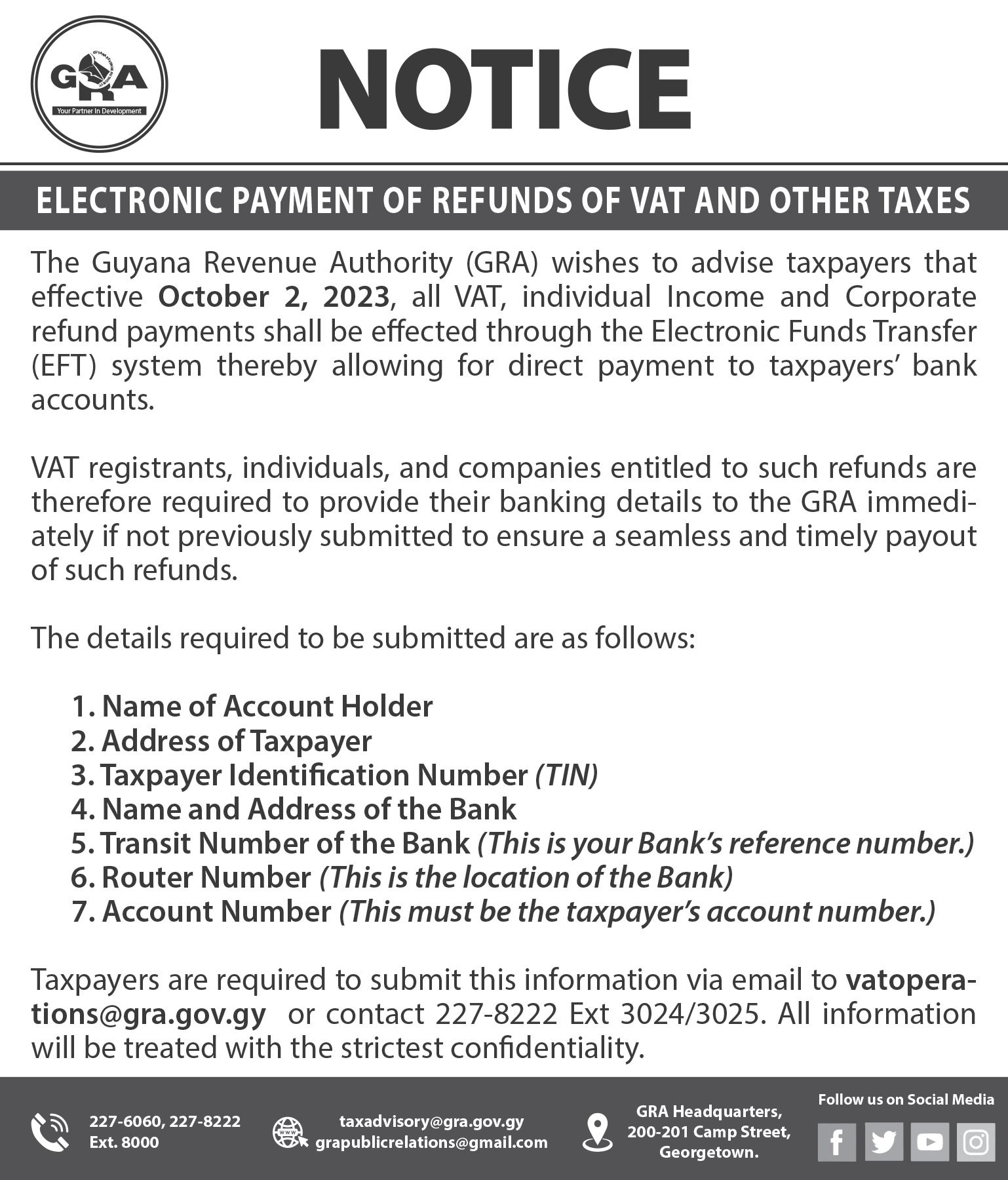
covery of 23 brick-like parcels of suspected cocaine and a 9mm pistol and a magazine with 14 matching rounds.
He was arrested and escorted to CANU Headquarters along with the suspected narcotic.
The narcotic tested positive for cocaine, weighing approximately 26.016 kilograms, almost 57.35 pounds, with a street value of approximately $27 million.
INTERNATIONAL Day of the World’s Indigenous Peoples was on Wednesday celebrated under the theme, “Indigenous youth as agents of change for self-determination.”
Minister of Amerindian Affairs Pauline Sukhai related in a message for International Day of Indigenous Peoples that the government of Guyana is invested in ensuring that it hones and builds the skills and capacity of youths.
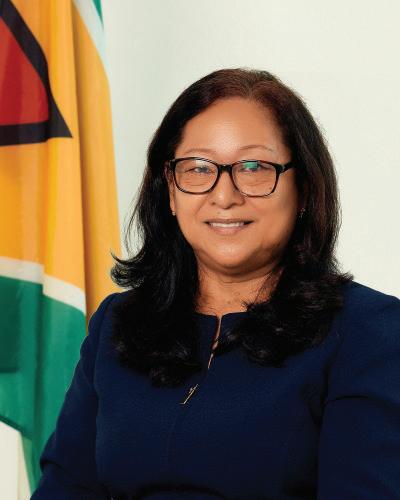
“Indigenous youths are primary targets in this developmental approach towards furthering meaningful change and development in their villages and communities,” she said.
According to her, Indigenous youths have been taking their rightful place in advocacy and as agents for change in the promotion of Indigenous peoples’ rights in Guyana.
“More and more, we are seeing indigenous youths being voted into offices and endowed with decision-making powers as Toshaos and Councillors. At the national
level, the President of Guyana, recognising the huge power youths have as agents of change, has established a National Youth Council with advisory powers to ensure that there is inclusivity, encapsulating the indigenous youthful voice in policy making at the highest level,” she explained.
Through the Youth Entrepreneurship and Apprenticeship Programme, youths are provided with valuable capacity-building opportunities through training in small engine repairs, tractor driving and maintenance, garment construction, empowerment and tourism and hospitality.
These youths have returned to their respective villages to boost their agriculture production and community transportation needs.
Additionally, she said that access to quality education has a key role to play in Amerindian development, which is why there are continued efforts by the Government to ensure all Hinterland students have access to education through online and national scholarships.
“The Hinterland Schol-
arship Programme being implemented by the Ministry of Amerindian Affairs has produced a remarkable number of young professionals and advocates in indigenous
issues. This programme, as well as the tertiary dormitory, continues to be widely utilised by our indigenous youths to ultimately enable them to become the cata -
lysts of change and advocacy through education,” she related.
Further, she said that in Guyana there continues to be significant strides being made in ensuring the rights of Indigenous people are fully promoted and realised.
This is seen through the Amerindian Act 2006 which specifically seeks to protect and promote the rights of our Amerindian peoples.
“Significantly, the Amerindian Act 2006 sets out the process for legal recognition of Indigenous people’s traditional lands, a process that is funded by the State. Any path to self-determination by Indigenous people is paved through ownership of their lands; land is an indispensable part of Indigenous peoples’ identity,” Minister Sukhai noted.
To date, there are 106 titled villages in Guyana, as the government remains committed to ensuring land tenure for Amerindians.
The Amerindian Land Titling Project is mandated to furthering land security for indigenous people collectively in Guyana, which she
said is the first, and perhaps most important step towards recognising our Indigenous peoples and to promoting self-determination.
Moreover, taking the theme into consideration, she noted that the elders of communities have an extremely valuable role to play in preserving traditional knowledge and of equal importance is the role that youths have to play in the same way.
“While there exists traditional knowledge, it is absolutely quintessential that there be in place a relationship between the elderly and the youths to ensure there is transmission of and ultimately preservation of indigenous knowledge,” Minister Sukhai said.
She related that in the conversation on self-determination, the National Toshaos Council is the duly authorised and statutorily established Indigenous people’s leadership body comprising all Toshaos, which has seen the growing inclusion of youth representation in its core executive membership as elected by the wider body.
GOVERNMENT had to reverse and regularise the illegal sale of lands at Peter’s Hall, East Bank Demerara, that was facilitated under the A Partnership for National Unity + Alliance For Change (APNU+AFC) administration in 2018.
This was revealed by Senior Minister within the Office of the President with responsibility for Finance, Dr. Ashni Singh on Wednesday, while responding to questions posed by Opposition Member of Parliament Annette Ferguson during Tuesday’s sitting of the National Assembly.
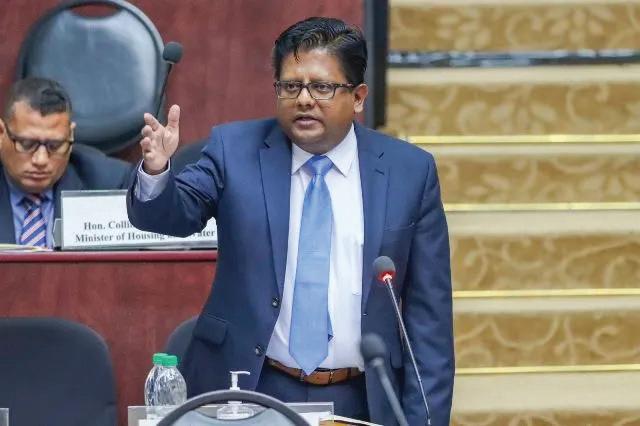
Dr. Singh revealed that
there was no selection by the government in relation to whom these lands were sold. However, he noted that they’d inherited a list of people who were sold lands without not only due process but without any transparent process being followed.
“In fact, Sir, the records will reflect that in 2018, under the APNU+AFC administration, government entered into lease transactions for lands on the East Bank of Demerara, including at Plantation Peter’s Hall, and granted leases that allowed the lessees to sell, with several defects, including most signifi -
cantly that granted these lessees the right to sell and assign their rights in the respective properties to third parties, some of whom did exactly that, making substantial profits,” Dr. Singh said.
The foregoing, he
said, was a principal defect in these transactions, as these sales and assigning of rights could be done without any reference to any State approval or State authority.
Added to this, he said that it is also a matter of
public record that this was part of a series of land giveaways by the then illegal APNU+AFC government.
The government, Dr. Singh said, embarked on a process of reviewing these leases, and identifying the fundamental defects, violations and breaches, and made an effort to regularise these transactions.
He said, “We made an effort to regularise these transactions, and we engaged with all of the persons holding these lands, and some agreed to relinquish, recognising that due process was not followed; in some cases,
lands had even been vested without a single cent having been paid, with no reference to Cabinet.”
During the course of the engagements, he said, while some agreed to relinquish, others opted to go to the courts to challenge the proceedings.
Against this backdrop, he noted that in some of these matters, there are pending criminal charges engaging the attention of the court.
He then emphasised that the PPP/C government did not select those persons, as the list was inherited from the previous administration.

THE University of Guyana Centre for Communications Studies (UGCCS) will be graduating the first batch of students who completed the Master’s Degree in Communications Studies for the year 2023.
Dr. Carolyn Walcott, the programme’s coordinator, spoke with the Daily Chronicle and shared that they will be graduating their first cohort of seven students this year. Additionally, she mentioned that they are receiving applications for the second cohort, and aspire to draw in a larger number of students.
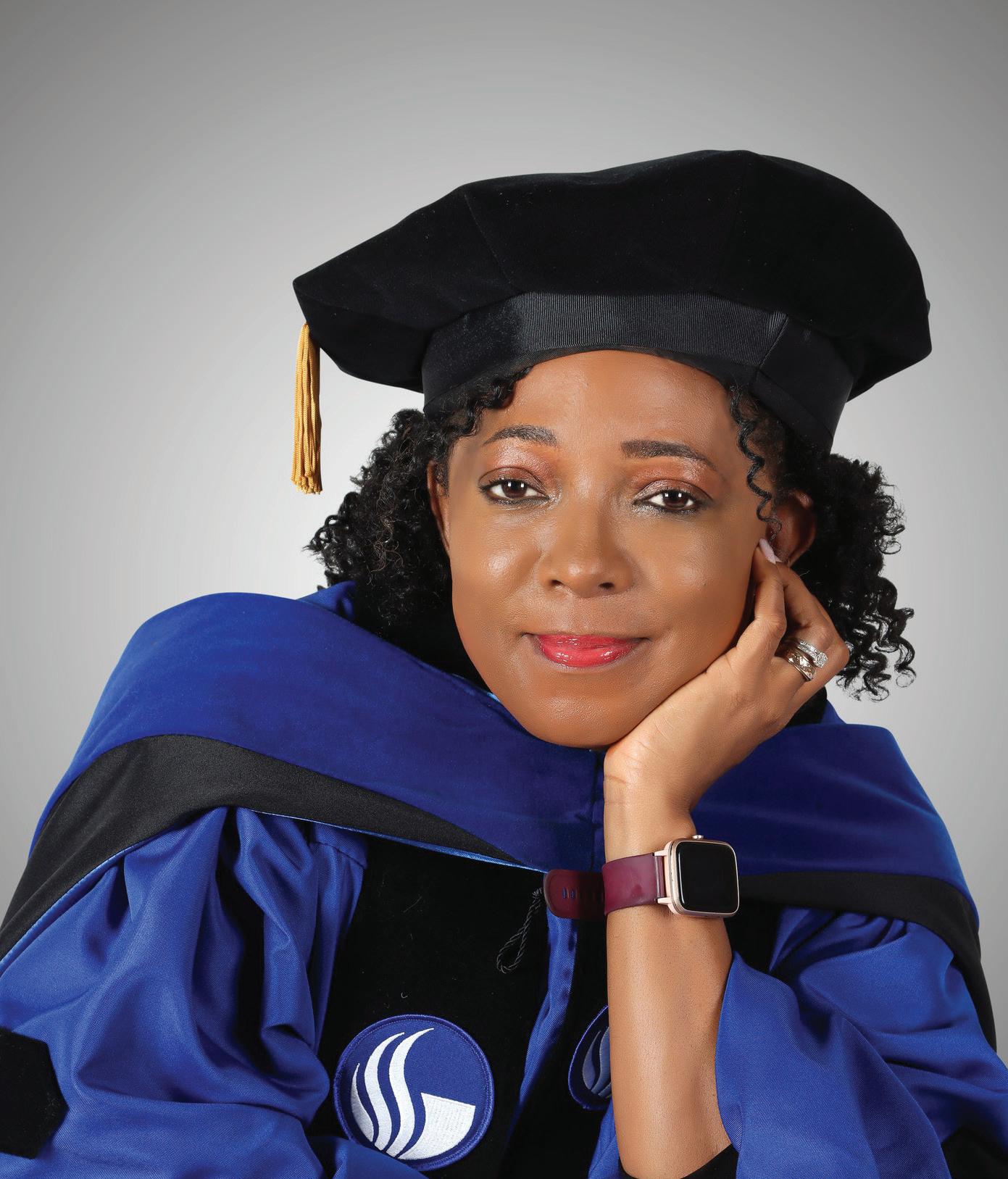
Dr. Walcott stated that the Master of Social Science in Communications Studies was conceptualised around 2007 as part of a grand project called Phoenix. This project sought to rebuild the physical and human infrastructure of the UGCCS.
“At that time, the UGCCS was led by Professor Paloma Mohamed-Martin, UG’s current Vice-Chancellor, who, along with the small team of faculty, envisioned and developed a revitalised curriculum, with critical support from international and local stakeholders.” Dr. Walcott said, adding:
“Sustainable development and the establishment of key linkages between stakeholders (both internal and external), to foster knowledge sharing and capacity building also reside at the heart of the programme.”
The master’s programme was earmarked as part of the strategic offerings of the UGCCS to provide undergraduates with advanced theoretical and practical training for careers in media and communications.
In two years (four semesters), students are taught both core courses, and those under their specialisation. It was stated that students have an option of completing the requirements within two years, or they can opt to develop a four-to-fiveyear plan of completion. Dr. Walcott cautions, however, that while they encourage diligence in exercising the available options, they also recognise the need for flexibility, given the pressures of a work-school-life balance that many often juggle.
The first three semesters comprise 11 taught core courses. These are inclusive of one elective and one internship, in addition to four taught courses per specialisation. Among the
courses being taught are: Persuasion and Ethics; Social Change Communication; Research Methods; Project Management; Crisis Communication; Social Media Use and Abuse; Communicating Public Policy; and Data Visualisation. During the final semester, students will undertake either an individual practical project, or a research-based thesis applicable to the selected specialisation. Students, in addition to this, are offered three major areas of specialization, these being: Strategic Communication; Social Change Communication; and Visual Communication. Compatible with these areas are the overall aims of capacity building for corporate employees, in both the public and private sectors, as social change agents, or those who wish to shape the world through imagery.
The Master’s Programme is built with the aim which includes providing both culturally sensitive, innovative, and specialized curricula which address the knowledge gaps associated with locally and regionally produced programmes and projects; this includes research, in Strategic Communication, Social Change Communication, and Visual Communication.
Moreover, the programme also seeks to provide students with a strong foundation to follow their academic goals beyond a master’s degree level; all while nurturing the ethical creation, implementation, and evaluation of programs and projects that will contribute to local and global solutions.
chronous. Apart from their academic credentials, the lecturers on the programme have significant expertise in their respective fields which augers well for knowledge transfer in an evolving media and communication discipline.”
She noted that in a
post-Covid era of online education, many tertiary institutions abroad offer online options for graduate students who must adapt and function independently in some instances. However, in Guyana, the live classes are created to facilitate engaged learning and
application for students who are also exposed to real case studies. Furthermore, students engage in group discourses and projects that help to build their skillset individually and collectively as communication and social change strategists.
Those candidates who meet any of the following requirements are welcome to apply to the programme. These requirements include A Degree in Communications Studies from the University of Guyana, or its equivalent from a recognised institution with at least a 2.7 GPA on a 4.0 scale (credit); a bachelor’s degree, deemed as suitable with at least a 2.7 GPA on a 4.0 scale (credit); mature applicants (26 years and over) with a Degree in Communication, or related discipline.
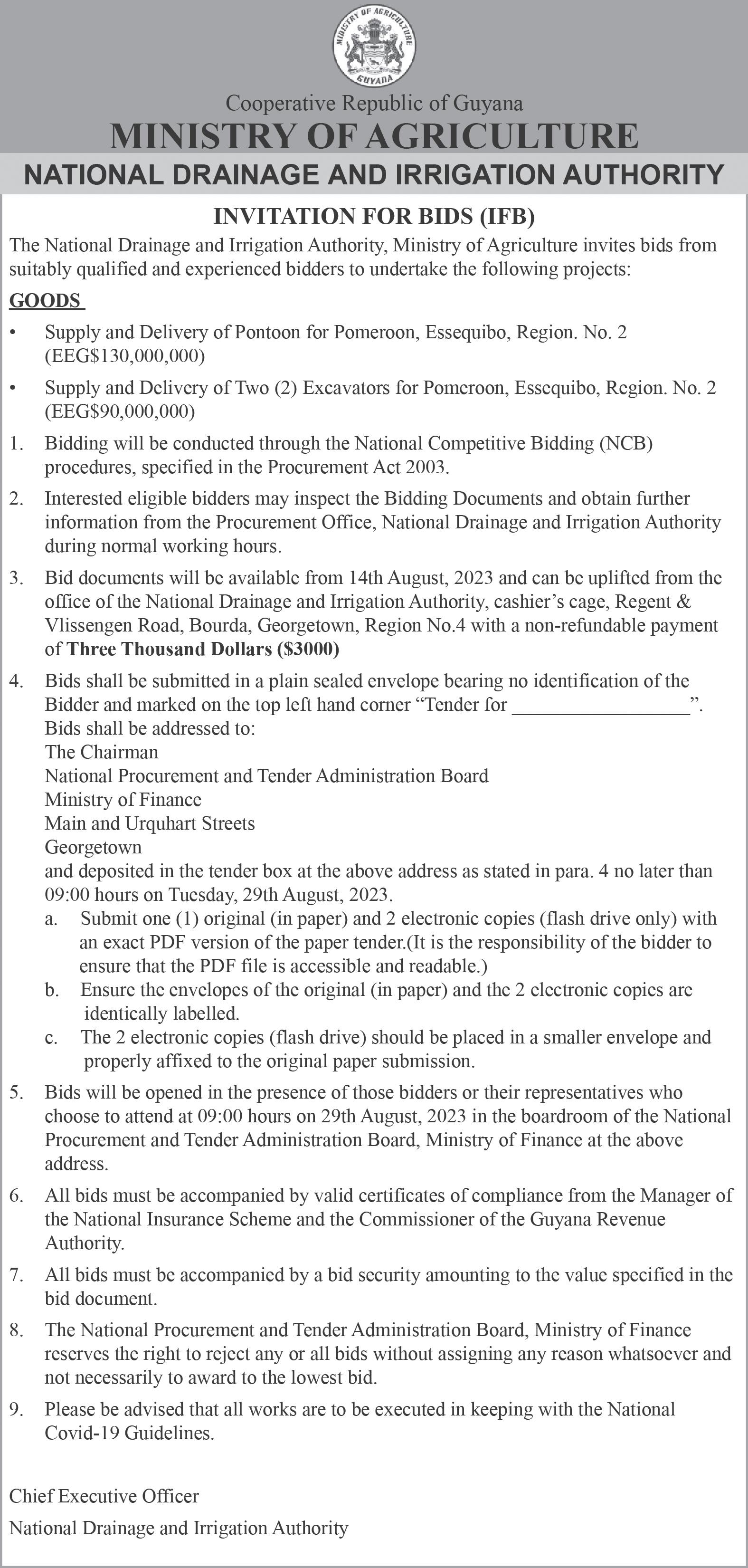
Transfer students will be evaluated under the University’s regulations, and be awarded exemptions, where applicable, on acceptance into the programme. However, the minimum requirements for entry must be met; any other qualification considered by the University to be equivalent to any of the above, or acceptable.
Based on the above, applicants who wish to change careers and may not have a media background are also welcome to engage in the programme of study.
Dr. Walcott said, “While we recognize that our students have options, the master’s programme offers students a space to learn and create at the same time. We also have a pool of dedicated and highly qualified instructors drawn from Guyana and abroad, who teach live online rather than asyn-
THE American University of Peace Studies (AUOPS), a research-based institution, on Wednesday, launched the “Center of
Research and Strategic Thinking: to promote Scientific Objective Analysis.”
The center will do poll sampling as it relates to is-
sues in Guyana, as well as research on current issues so that the relevant stakeholders can use the research findings to guide policy decisions,
enhancing the welfare of Guyanese.

According to Dr. Eton Simon, Chief Executive Officer (CEO) of the AUOPS, the
center will conduct innovative scientific research, which he said is going to transform Guyana.
“We should have research centers in every corner of this country conducting research on all different topics. If we can have that we will make a tremendous breakthrough because the pace at which research will bring you critical information, it will bring you vital knowledge so that you can make the right decisions,” Dr. Simon explained.
The center, he said, will embark on an innovative scientific research venture in conducting social, economic environmental and institutional research in Guyana, which will help to advance Guyana’s society in an ever changing world.
He noted that as Guyana finds itself to have one of the fastest growing economies, a lot more is needed to be done for sustainable development.
Dr. Simon explained that poll sampling, used often in the United States, gives leaders an idea as to what people are thinking. Leaders then use this information to help in decision making.
“Research is the catalyst for solving problems Guyana is facing. It will also increase the quality of life and decision making and enhance the health and wellbeing of all Guyanese. Research will allow us to better understand the world that we live in and find solutions to problems,” he related.
Dr. Simon added that research empowers citizens to help in gaining knowledge, progressing forward and it also helps to foster economic growth by fuelling innovation, entrepreneurship and
job creation.
“It will make certain decision making by providing evidence-based insight and mitigating risk. Our research will help to raise awareness of issues relating to work place, social, mental, educational, just to name a few,” he noted
Given the rapid changes the world is going through, he said that research will play a pivotal role in finding solutions to complex problems.
In order to make their findings from research available to the public, the Center of Research will conduct regular research briefings, and it will also host an annual research conference in Guyana.
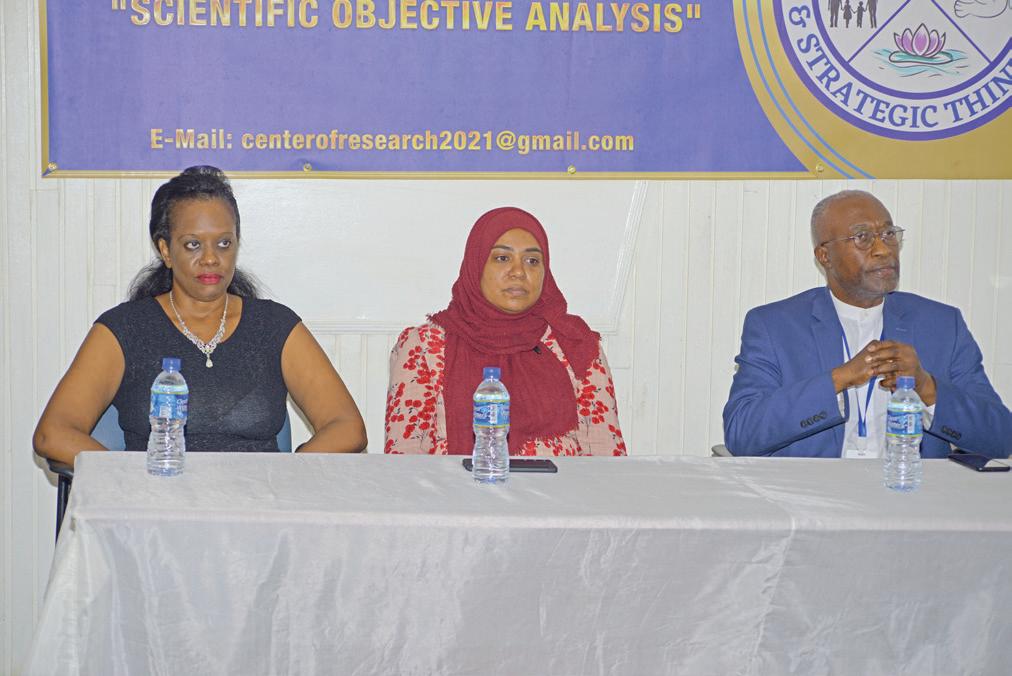
Research will be done by the AUOPS research body, which is fully trained by the institution.
Moreover, Dr. Nadine Ramsarran, Director of Curriculum and Academic Affairs, said that it is their responsibility to conduct research and present their findings to the appropriate persons, depending on the issues, and then having them work to make changes for the further development of Guyana
The AUOPS intends to create more research centers throughout the various regions of Guyana.
AUOPS has been facilitating Guyanese and International Students in qualifying and upgrading their knowledge and skills to be functional in this dynamic society for the past 22 years. The institution focuses on using empirical data to facilitate the needs of the populace.
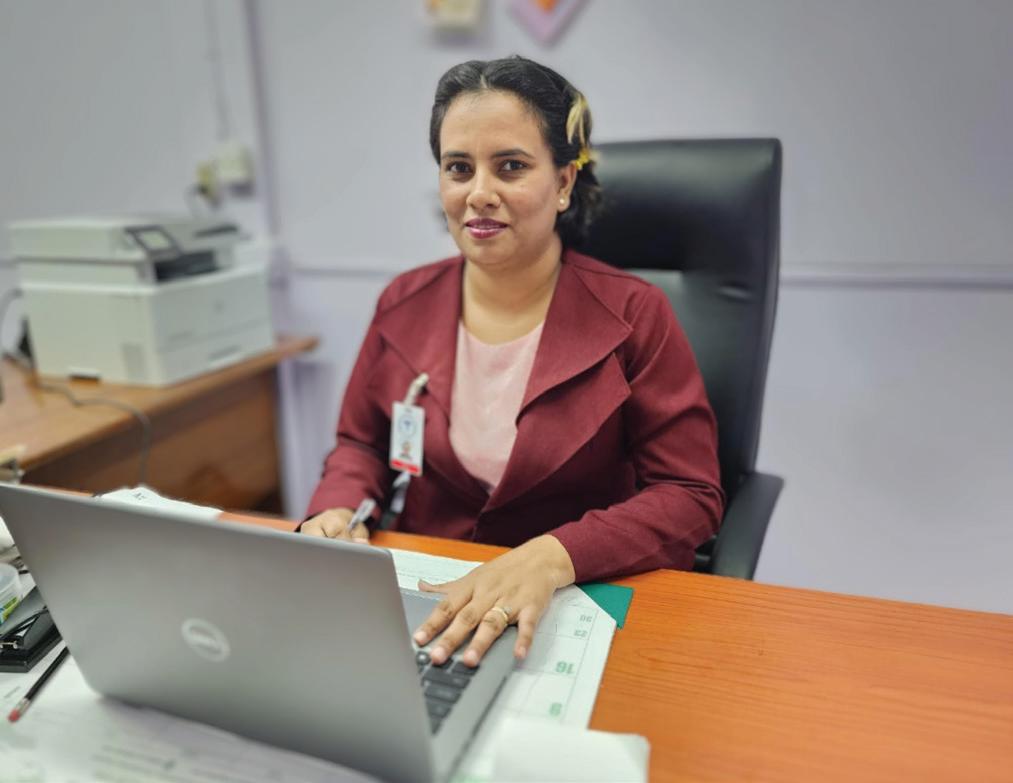
THE Georgetown Public Hospital Corporation (GPHC) announced a significant advancement in its Pathology Department with the recent acquisition of a state-of-
medical excellence,” the GPHC noted in a press statement.
Moreover, as part of GPHC's commitment to continuous improvement, the Pathology Depart -
the field.
Robbie Rambarran, CEO at GPHC, expressed his enthusiasm for the ongoing efforts to expand the department's scope and improve overall effi-
ciency.
“Our commitment to advancing patient care is unwavering. We are continuously exploring avenues for further engagement and advance -
ments in technology to achieve greater efficiency and expand our services,” he stated.
The GPHC said its Pathology Department looks forward to contin-
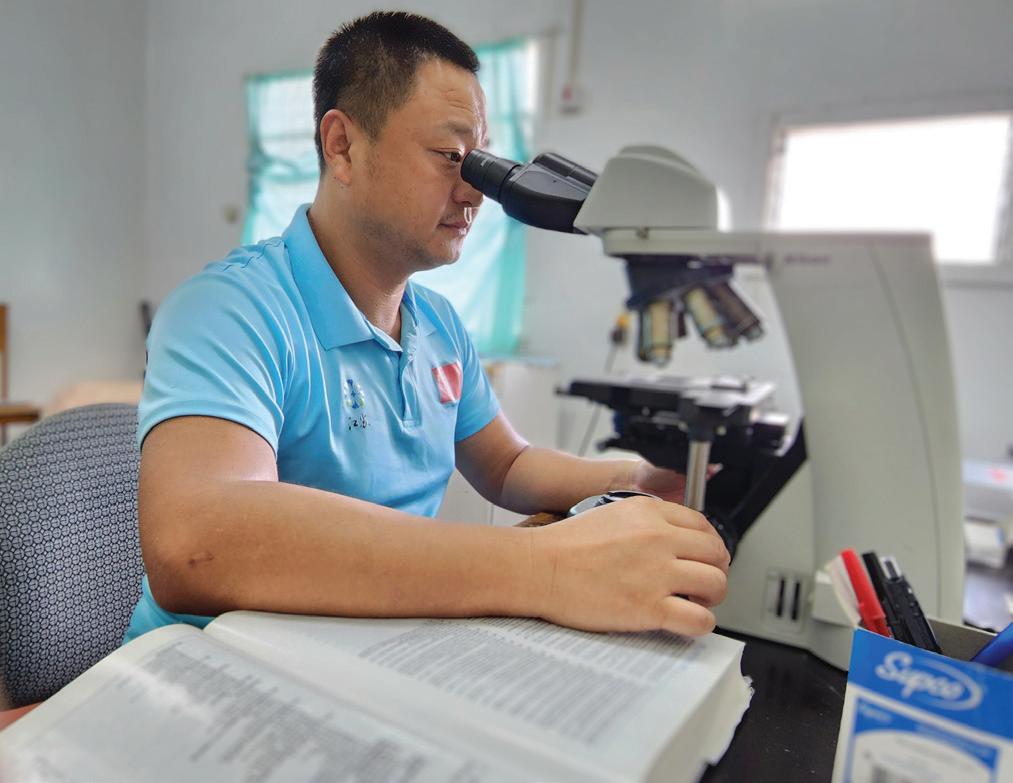
ually collaborating with esteemed partners and stakeholders to push the boundaries of medical expertise, ensuring our patients receive the best possible care.
the-art microtome machine and an advanced auto tissue processor.
These two innovative technologies have allowed the department to revolutionise sample processing, reducing the turnaround time from over 30 days to an impressive seven days.
According to the GPHC, these two cutting-edge additions represent a remarkable leap in the efficiency and accuracy of sample processing, enabling the hospital’s esteemed team of Pathologists to provide rapid and precise diagnoses.
“The quicker turnaround time translates to expedited diagnosis, patient care and ultimately enhances our ability to serve the community with the highest standard of
ment has made substantial strides in personnel and organisational development. More recently, a new Laboratory Manager and an additional Pathologist have been appointed, further strengthening the department's expertise and capacity to handle a higher volume of cases effectively.
In tandem with the personnel expansion, the department underwent a complete restructuring, streamlining workflows and optimising resource allocation. The implementation of training programmes conducted in collaboration with the Guyana National Bureau of Standards has ensured that the staff is equipped with the latest best practices and knowledge in
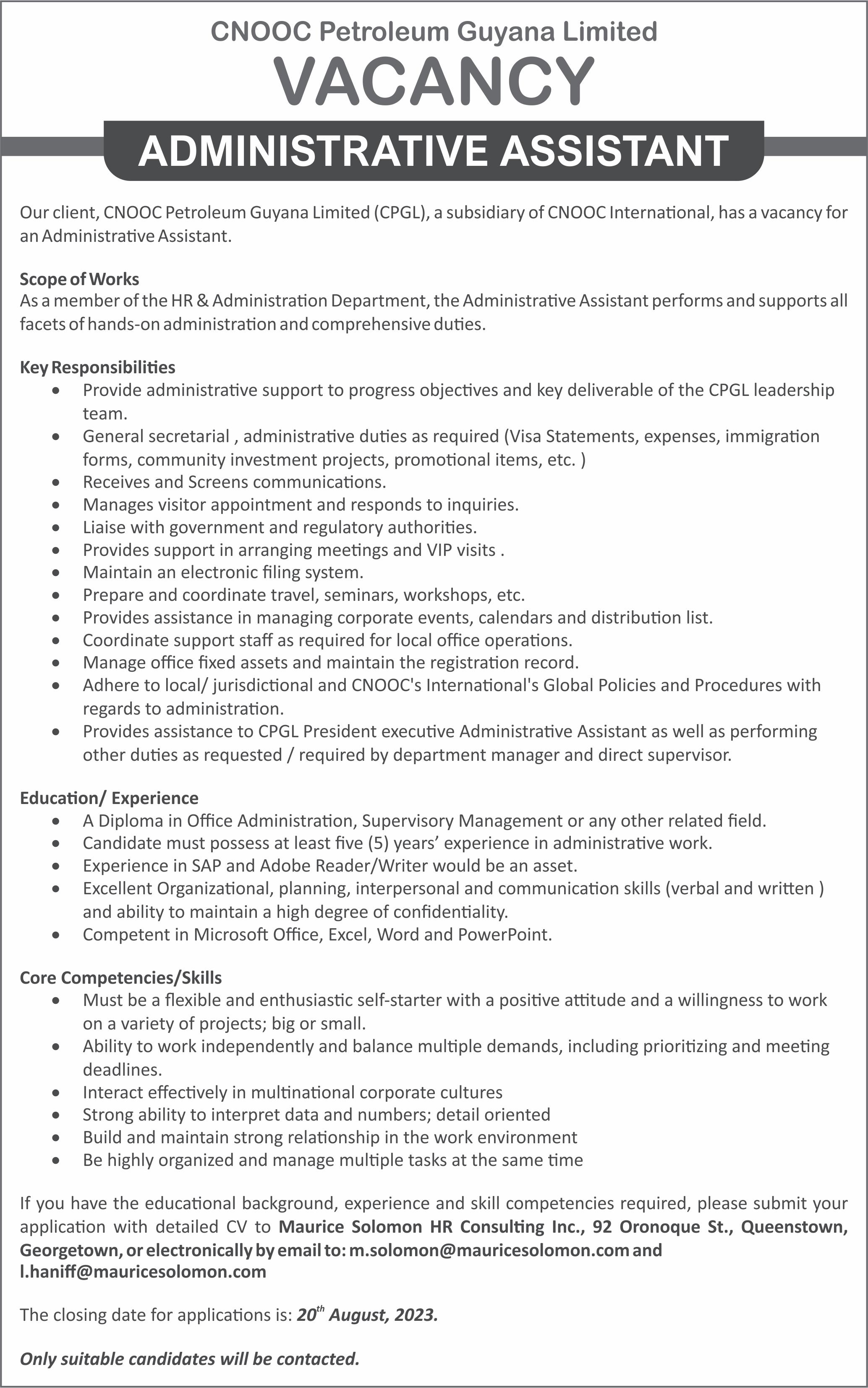

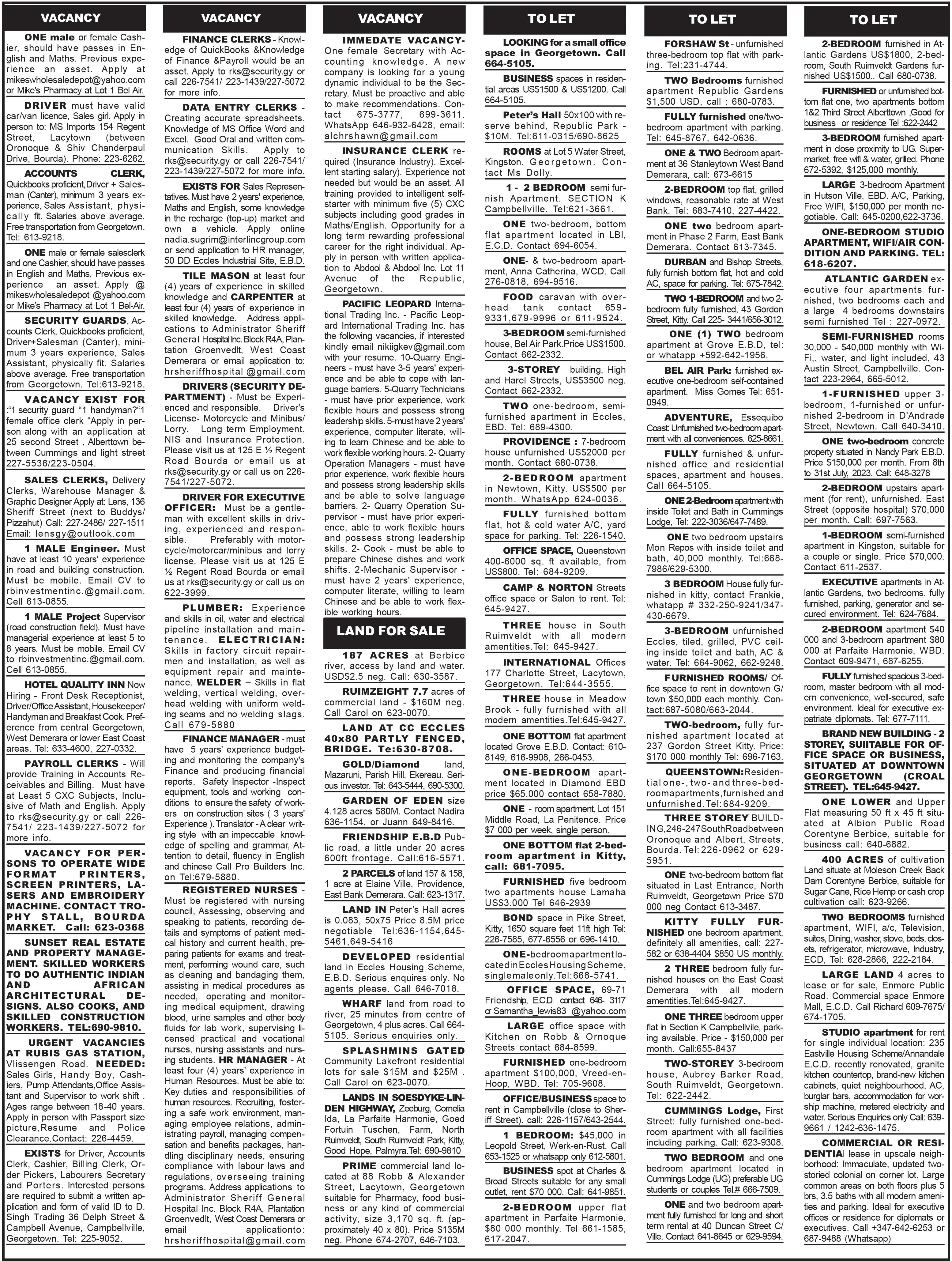
(Thursday August 10, 2023)
CUMMINGS ELECTRICAL COMPANY LTD-83 Garnett Street, Georgetown (Tel: 225-6158)
Answers to yesterday’s quiz:
(1) 324 runs (17 matches)
(2) 177 runs (5 matches)
Today’s Quiz:
(1) Who has represented the West Indies in most T20 Internationals to date?
(2) How many T20 International games M S Dhoni has played for India?
Answers in tomorrow’s issue
RACING TIPS
English Racing Tips
Nottingham
09:10 hrs Grey Cuban
09:40 hrs Belle Fourche
10:10 hrs Dunes King
10:40 hrs Warren Hill
11:10 hrs Mascani
11:45 hrs My Honey B
Chepstow
12:30 hrs United Front
13:00 hrs Eminny
13:30 hrs Ramiro
14:00 hrs Shahbaz
14:30 hrs Dancing In Paris
15:00 hrs Manila Scouse
15:30 hrs Accidental Agent Sandown
12:45 hrs Alazwar
13:15 hrs Batal Zabeel 13:45 hrs State Of Desire
hrs Muktamil 14:45 hrs Riot 15:15 hrs D Day Odette

Irish Racing Tips Sligo

12:05 hrs Desert Friend
12:35 hrs Coole Cherry
13:05 hrs Timourid
13:35 hrs Downtherefordancin
14:05 hrs Weseekherthere
14:35 hrs The Four Sixes
15:05 hrs Mount Sinai
American Racing Tips Saratoga
Race 1 Into Stars
Race 2 Montauk Mystique Race 3 Our Country Race 4 Dates Freedom Race 5 Book Of Wisdom Race 6 Le Dom Bro Race 7 Beautufulnavigator South Africa Racing Tips

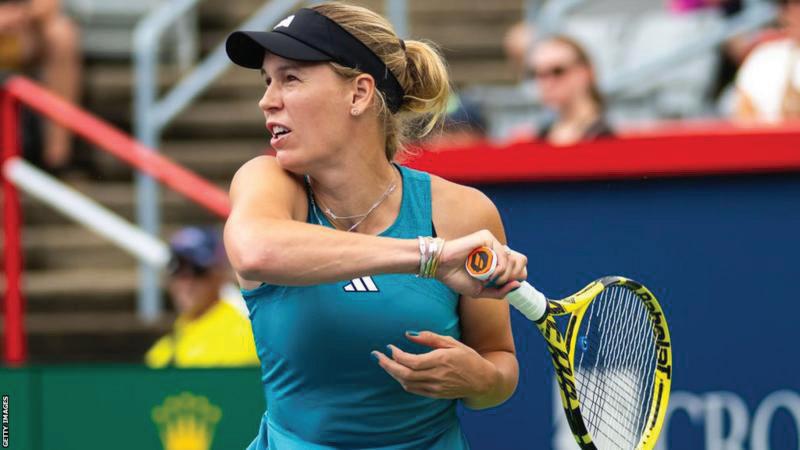
(BBC) - Caroline Wozniacki said she was "definitely a little rusty" following her first-round victory at the Canadian Open on her return to tennis after retiring in 2020.
The former world number one, 33, has since given birth to two children and beat qualifier Kimberly Birrell of Australia 6-2 6-2 in Montreal.
"It feels great," said Wozniacki.
She will face Wimbledon champion Marketa Vondrousova, who beat Mayar Sherif 6-4 6-2, in the second round.
Of her return to action, Wozniacki added: "What an amazing place to come back and play my first match. I love playing here in Montreal.
In June, the Dane announced her desire to play in this year's US Open. She reached the final of the tournament in New York in 2009 and 2014.
Soon after the interview with Vogue, Wozniacki was handed a wildcard for the event at Flushing Meadows, which begins on 28 August.
She had not played a
competitive match since the Australian Open more than three years ago, and became a mother to daughter Olivia in June 2021 and son James in October 2022.
Wozniacki called her first win as a mum "pretty crazy" and said her children would be "napping right now, which is awesome".
"I'm going to catch them after I do a little bit of treatment and food and stuff," she added. "That's the good part
of playing early, I still have the afternoon with them."
Wozniacki dropped the opening game but rallied to take the final four games of the opening set, before securing the match in the second set by breaking 115th-ranked Birrell with a backhand winner.
Her next opponent Vondrousova was featuring for the first time since her victorious campaign in SW19 when she beat Ons Jabeur in
the final.
"People around me, I feel like they're going to expect so much now," the Czech said.
"I know if you're a Grand Slam champion, the expectations are very high but for me, it's important to stay in my small circle and just work on things.
"[I want to] just get through some matches, with nerves and everything.
(BBC) - Anthony Joshua says boxing "clearly has a problem" with doping after Dillian Whyte failed a voluntary drug test and was pulled out of Saturday's all-British heavyweight contest.
Joshua, 33, will instead fight Robert Helenius at London's O2 Arena, with the 39-year-old Finn taking the fight at just a week's notice.
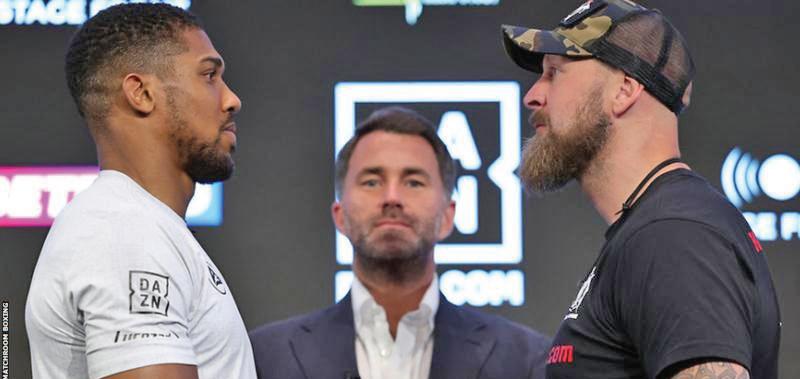
Asked by BBC Sport if boxing has an issue with doping, Joshua said: "I don't know how they're going to sort it out or what their solution is to this problem. But it clearly has a problem."
For the third time in 12 months, boxing is facing serious questions about the sport's credibility and its anti-doping protocols.
In October last year Conor Benn's bout with Chris Eubank Jr was cancelled in fight week after it emerged Benn had failed two voluntary drug tests. Benn has always protested his innocence, as does Whyte.
Amir Khan was banned for two years after an anti-doping test revealed the presence of a banned sub -
stance following his fight against Kell Brook in February 2022.
The case was not heard by an independent tribunal until January 2023.
On Tuesday it was confirmed Joshua would instead fight Helenius. It is the second time Joshua has had to pull an opponent from a fight due to
an anti-doping violation.
In 2019 Andy Ruiz Jr stepped in on a month's notice when American Jarrell Miller tested positive for several banned substances.
Joshua has paid for extra testing by the Voluntary Anti-Doping Association for several years to go hand-inhand with UK Anti-Doping Agency's (Ukad) testing.
In their latest report, Ukad carried out 213 in-competition tests and 133 out-of-competition tests on fighters connected to the British Boxing Board of Control (BBBoC).
However, in global boxing there is no standardisation of anti-doping rules, leading to fighters, like Joshua, choosing to insist on additional steps to provide regular testing.
- Nine matches in the upcoming ODI World Cup have had their dates or start times changed, the ICC has finally confirmed, including the India-Pakistan fixture in Ahmedabad, which will now be played - as reported earlier by ESPNcricinfo - on October 14 instead of October 15. The changes were confirmed by the ICC with less than two months to go before the start of the game's showpiece event.
Pakistan, Bangladesh and England are the most affected, with the three sides having three games changed by date (and one for start time in England's case). As a result of the change in the India-Pakistan game, Pakistan's match against Sri Lanka in Hyderabad has been moved from October 12 to October 10, to give them an adequate gap leading into their India match. But as a result, the Australia-South Africa match in Lucknow has also been brought forward a day and will take place on October 12 instead of October 13.
The England-Afghanistan game in Delhi, which was originally scheduled for October 14, will be played on October 15.
New Zealand's match against Bangladesh in Chennai has been changed from a day game on October 14 to a day-night fixture on October 13. The England-Bangladesh game in Dharamsala remains on October 10, but it will now be a day game and not a day-night contest.
The double-header scheduled for November 12 - Australia vs Bangladesh in Pune and England vs Pakistan in Kolkatawill now be played on November 11, following concerns raised by Kolkata police to the Cricket Association of Bengal about holding a match on the
same day as the Hindu festival of Kali Puja.
The league stage of the World Cup will now end with India playing Netherlands in Bengaluru on November 12, instead of November 11. The World Cup starts on October 5 with defending champions England taking on New Zealand in Ahmedabad, and culminates in the final on November 18, also in Ahmedabad. The semi-finals will be played in Mumbai and Kolkata on November 15 and 16 respectively. The ICC also announced that tickets for the event will go online from August 25.
The schedule of the 2023 ODI World Cup was released after a long delay on June 27, just 100 days before the start of the tournament on October 5 in Ahmedabad, whereas the schedules for the last two tournaments in Australia and New Zealand (2015) and England and Wales (2019) were out more than 12 months in advance.
It later emerged that the local police in Ahmedabad had raised concerns over providing adequate security on October 15, the original date of the India vs Pakistan game, which is also the first day of Navaratri, a major, nine-day Hindu festival.
Jay Shah, the BCCI secretary, had, however, dismissed that as the reason. "If security was an issue then why would the match go there [to Ahmedabad] - 14-15 is not the problem," he had said after a BCCI meeting on July 27. "Two or three boards have written in, asking to change based on the logistical challenges. There are some matches where there is only a two-day gap, so it will be difficult to play and then travel next day [and then play again]."
On Wednesday afternoon, the Guyana Cricket Board (GCB) president, Bissoondyal Singh, visited the national under-17 team at the LBI hostel.
The team had their final session yesterday as they completed preparations for the upcoming Cricket West Indies (CWI) Rising Stars
Regional Under-17 Tournament scheduled for August 11 to September 1, 2023, in Trinidad and Tobago (TT).
In the short meeting held, Mr Singh encouraged the group to be inspired by the Guyana under-13 team that returned today with a 2-0 series victory over their TT counterparts.
The victorious under-13 squad stopped by the hostel proudly displaying their hard-earned trophies to the GCB president and the under-17 boys before returning to their respective counties.
The GCB held a 12-day training camp for the national under-17 team during which they played two 2-day prac-
tice matches and a 50-overs match.
Under the guidance of Cricket West Indies (CWI) Level 2 coach Quasen Nedd and Neil Rudder, the team underwent intense training sessions in mostly favorable weather conditions unlike the rainy weather all the other national teams experienced
during their encampment period prior to their respective tournaments.
The preparation should make for a prepared and confident unit seeking to become the first team to win the regional under-17 tournament.
This year’s regional under-17 tournament will have a 2-day format as well as a
50-overs format.
The GCB president handed over several cricket equipment to some of the players after the meeting.
He closed by giving the team his full support and encouraged them to do their best as the GCB and Guyana feel confident they can return as champions.
The Guyana Boxing Association (GBA) has officially selected a 21-member fight roster that will be tasked with defending home turf in the prestigious Winfield Braithwaite Caribbean Schoolboys/Juniors Championship.
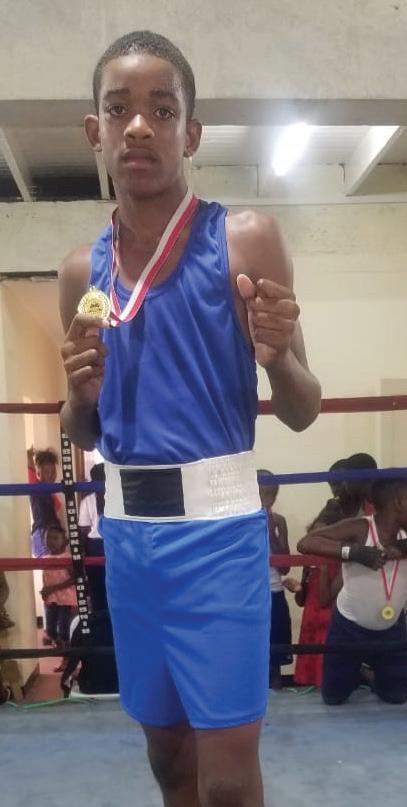
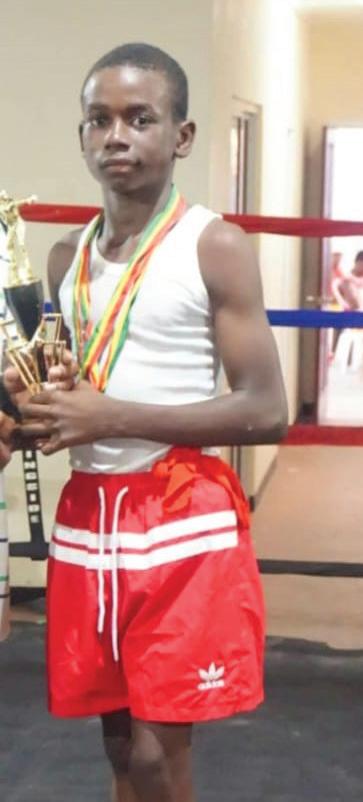
The programme is set for August 18th-20th at the National Gymnasium, Mandela Avenue.
The team, which features two female pugilists, includes representation from the Forgotten Youth Foundation, the Guyana Police Force, Andrew Lewis Gym, Rose Hall Town Jammers, Vergenoegen, and the Pace and Power Boxing Gym.
The team comprises [Rose Hall Town Jammers] Shimroy Wings, Raham
Peters, Travis Sancho, Matthew Sancho, Kenyon Hamilton, and Joffes Jackson; [Vergenoegen] Keyon Britton, Markel Blue, Joel Hinds, Garvel Hyman, and (female) Tianna Moore; [Forgotten Youth Foundation] Wayne Castello, Tiquan Sampson, Shakquain James, and (female) Akeelan Vancooten; [Pace and Power], Khamuda Alexander, Ken Harvey, and Ryan Rodgers; [Andrew Lewis] Eon Bancroft and Leon Albert; and [Guyana Police Force] Chance Niles.
The GBA had commenced its arduous selection process with its monthly U-16 Championships, which were hosted at the Andrew ‘Six Head’ Lewis Gym, Albouystown and the National
Gymnasium.
Upon the end of the previous competition in July, combatants were shortlisted for further assessment which resulted in the aforementioned cadre being selected.
The team will be encamped to continue the preparatory phase and will be once again under the supervision of the GBA coaches Lennox Daniels, Sebert Blake, Clifton Moore, Francisco Roldon, and Technical Director Terrence Poole (MS).
Steve Ninvalle, President of the GBA, said that the selection was a result of a thorough and structured process which commenced months in advance of the impending championship.
The team will be under the watchful eyes of the associ- ation’s technical machinery,
whose sole objective is to prepare our pugilists to defend home turf, Ninvalle pointed out. " While we would have prevailed on each occasion as the overall winner, we simply cannot utilise past results as a barometer," Ninvalle added.
“As a consequence, we will leave no stone unturned in our continued preparation to maintain our dominance in the region, as the competition provides a window, brief as it may be, into the future and overall imminent direction of the discipline in the region”, he further said. Guyana will join teams from Barbados, Bahamas, Grenada, St Lucia and Trinidad and Tobago at the tournament.
In steaming hot conditions at the MYO ground, Ace Warriors defeated Positive Foundation by 213 runs in the latest round of the Georgetown Cricket Association’s (GCA) New Building Society (NBS) 40-over second division tournament.
Led by Nkosi Whyte’s 80 from 84 balls with 13 boundaries, Ace Warriors made it to 254 in 36.2. Whyte, who batted in a
positive manner, shared in an 81-run partnership for the first wicket with Roger Aaron who was the silent partner, scoring 19 from 31 balls with one solitary six.
After Aaron was bowled by Idris Allen, Terrence King joined the wellset Whyte as both batters were willing to play their shots on the small ground.
Allen struck again when he trapped King LBW for 17 with two fours at 134-2
with Whyte dominating the 56-run stand.
Dequan Murray blasted a quick-fire 23 from just 16 balls and reached the boundary once and cleared it three times as he and Whyte, who reached his 50 with a confident cover drive, put together 31 before Murray was LBW to Sherwin Whyte.
Ganesh Lall had his stumps disturbed in the same over for a duck to
leave Ace Warriors on 1673
Whyte kept going while Junior Phillips also went after the bowling before Whyte, when in sight of a century, was run out.
Trevor Boston (12) was bowled by Sherwin Whyte with Shawn Thomson picking up the last two wickets as Phillips ran out of partners, finishing unbeaten on 32 from 21 balls with two fours and three sixes.
Sherwin Whyte had 3-41 while Joel Gilkes (2-64), Thomson (2-56) and Allen (2-41) were the other wicket-takers for Positive Foundation from Agricola who were bundled out for 41 from 12.5 overs as only Neil Hutson (10) reached double figures.
Murray had 4-6 and Lall took 4-13. (Sean Devers)
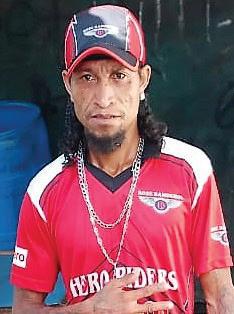
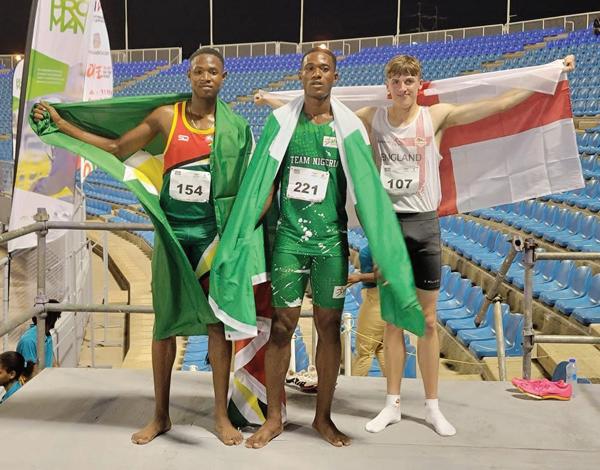
Three medals for Guyana thus far
Veterinary Inspection of all the horses entered to race on Guyana Cup Day will start on Friday and ends on Saturday.
Veterinary inspection was made compulsory by Jumbo Jet Thoroughbred Racing Committee (JJTRC) top brass, Nasrudeen Mohamed jnr.
The inspection process will start on Friday at Regions Five (5) and Six (6).
All participating horse-owners who have horses close to the stated venues are asked to comply with the request to have their horses pass the veterinary inspection.
On Tuesday evening, Tianna Springer clinched a historic first Gold medal for the Golden Arrowhead at the Youth Commonwealth Games following her impressive run in the women's 400m final at the Halsey Crawford Stadium in the twin-island Republic of Trinidad and Tobago. Springer, who had already won gold at this year's CARIFTA Games and South
American U-20 Championships, continued her mercurial improvement by completing the race in a remarkable personal best of 53.55 seconds.
The 15-year-old track sensation led the way for her competitors, with England's Charlotte Henrich finishing second at 53.65 seconds and fellow Guyanese athlete Narissa McPherson securing third place with a time of
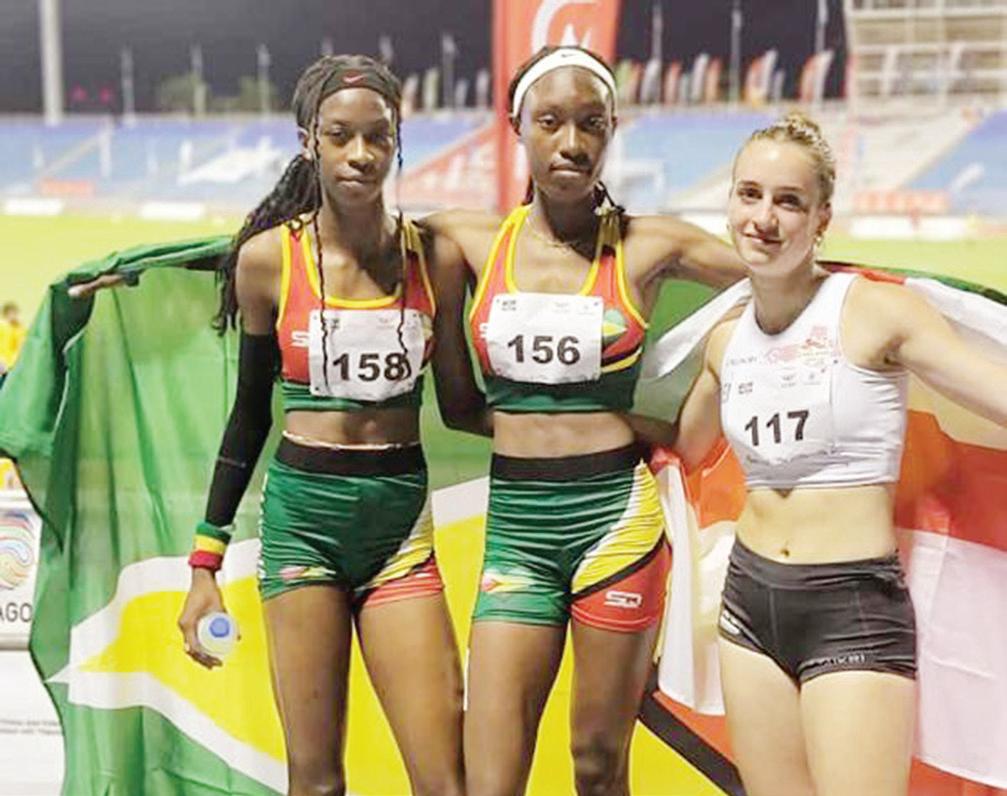
54.82 seconds.
In the men's 400m event, Malachi Austin earned a silver medal, adding to Guyana's total medal count of three in the seventh edition of the Games.
Austin delivered a personal best performance with a time of 47.97 seconds for the quarter-mile event. The gold medal was claimed by Nigeria's Uchenna Ogazi with a time of 46.99 seconds, while
England's Alexander Beck secured the bronze medal with a time of 48.20 seconds.
In an earlier race, Attoya Harvey finished in the 11th position in the women's 1500m final, completing the race in 4 minutes and 45.10 seconds.
The track and field events will continue with the upcoming highlights being the 200m and 800m heats and semi-finals.
The Rose Hall Community Centre Cricket Club is the latest beneficiary of the Cricket Gear for young and promising cricketers in Guyana, collecting a box of balls to aid them.
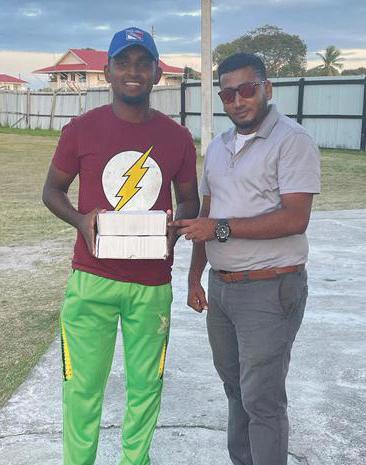
The rapidly rising club continues to produce many young cricketers who have already represented Guyana at the youth levels.
One such player is one of the fastest young bowler in the Caribbean, Isiaia Thorne, who has already represented the West Indies Under-19 team. In addition, young female cricketer, Ashmini Munisar, is the West Indies youth captain and has also represented the Senior Female Team.
On receipt of the balls, team coach Ameer Rahaman, expressed gratitude and promised to continue to serve the game in Guyana.
Rahaman is currently the head coach of the National Under-13 team which recently returned victorious from a bi-lateral series in Trinidad.
The project has received/ purchased so far: $370,000 in cash, thirteen colored cricket uniforms, two trophies, seventeen pairs of cricket boots, thirty-one pairs of batting pads, thirty-two cricket bats, twenty-nine pairs of batting gloves, twenty-three thigh pads, three pairs of wicket-keeping pads, five arm guards, two boxes, ten cricket bags, six bat rubbers, six helmets and one softball cricket bat. In addition to the above, $600,000 worth in gear was donated by Sheik Mohamed, former National wicket keeper/batsman. All cash collected is being used to purchase cricket gear requested and not available at the time.
To date, sixty-five young players from all three counties of Guyana have benefitted from three junior gear bags, two trophies, four arm guards, twenty-six bats, two boxes, five helmets, twenty-two pairs of cricket shoes, fifteen pairs of batting pads, two thigh pads, one bat rubber, twenty-four pairs of batting gloves and two pairs of wicket-keeping gloves.
In addition, two clubs in the Pomeroon area benefitted from two used bats.
The Pomeroon, Leguan and Wakenam Cricket Committees and the Cotton Tree Die Hard also received one box of red cricket balls each; Cold Fusion Cricket Club collected thirteen color uniforms while RHCCCC received three boxes of balls, fifteen white cricket shirts, one pair of junior batting pads, one pair of wick -
et-keeping gloves and a set of stumps and bails. Other beneficiaries are the Essequibo Cricket Board, the Town of Lethem and youth coach, Travis Persaud and softball teams in the Upper Corentyne area.
Cricket-related items, used or new, are distributed free of cost to young and promising cricketers in Guyana. Skills, discipline and education are important characteristics of the recipients. Talent spotting is being done across the country and club leaders also assist in identifying talent. Progressive and well managed cricket clubs with a youth programme will also benefit.
Anyone interested in contributing can contact Anil Beharry on 623 6875 or Kishan Das on 1-718 664 0896.
Kennard Memorial and will inspect horses there at 15:15hrs and close the day off at Bengal Paddy Drying Floor at 16:30hrs.
Resumption of the inspection process will continue on Saturday morning at GLDA compound, Georgetown from 8:00hrs.
A report of the inspection will be posted on the One Guyana Chat group site.
The JJTRC's spokesperson, Mohamed (Junior), declared, "This is about transparency and animal welfare, which is an international issue. I am asking horsemen to spread the message, and get their horses inspected."
If their horses fail the inspection they will be informed after the process is completed the same day.
It will be conducted by a team of professionals, and it will include independent personnel to be present when the inspection is being undertaken.
The inspection will start at the RSTC from 10:00hrs. The team will then proceed to Slingerz Stable from 11:00hrs. Then to Jumbo Jet Stable at 11:30hrs.
The inspecting team will then move across the bridge to region six (6), and will stop off at Jagdeo Racing Stable.
Inspection will start there at 14:00hrs after which the team will then proceed to Port Mourant at 14:30hrs.
They will proceed to
He warned, "Horses not inspected will not be allowed to race on the day. This process is to ensure that welfare of the horses entered to race on the day are looked after."
He advised, "This is a very big day in Guyana's horse racing calendar, and the eyes of not only the Caribbean, but the world will be focussed on us. He also revealed that the draw for the remaining seven (7) race will be done today after the entries are closed off.
He repeated the draw for those seven races has not been done. It will be done today.
The 15th running of the Guyana Cup will take place on Sunday 13th August, 2023 at the Rising Star Turf Club (RSTC)


